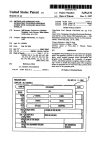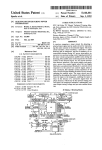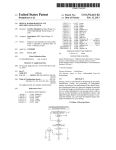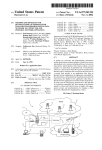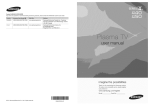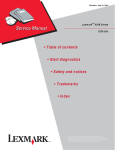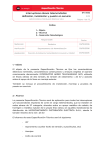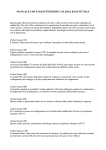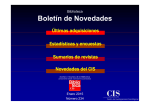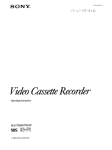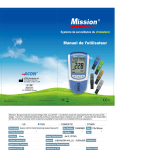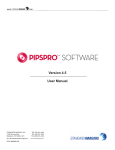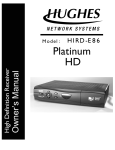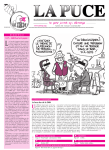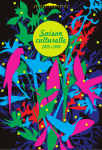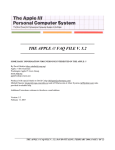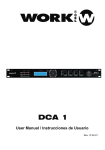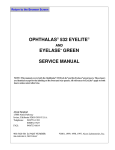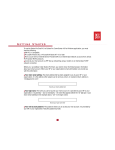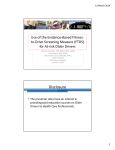Download c12) United States Patent
Transcript
111111
c12)
1111111111111111111111111111111111111111111111111111111111111
US008112776B2
United States Patent
(10)
Schein et al.
(45)
(54)
INTERACTIVE COMPUTER SYSTEM FOR
PROVIDING TELEVISION SCHEDULE
INFORMATION
(58)
(75)
Inventors: Steven M. Schein, Huntington Beach,
CA (US); Sean A. O'Brien, San Jose,
CA (US); Brian L. Klosterman, San
Ramon, CA (US); Kenneth A. Milnes,
Fremont, CA (US)
(56)
(73)
Assignee: Starsight Telecast, Inc., Fremont, CA
(US)
( *)
Notice:
(21)
(22)
(65)
Subject to any disclaimer, the term of this
patent is extended or adjusted under 35
U.S.C. 154(b) by 648 days.
U.S. PATENT DOCUMENTS
511977 Bernstein et a!.
3/1978 Miller
10/1979 Miller
(Continued)
FOREIGN PATENT DOCUMENTS
CN
1567986
1/2005
(Continued)
Prior Publication Data
Jul. 31, 2008
Continuation of application No. 11/147,802, filed on
Jun. 7, 2005, which is acontinuationofapplicationNo.
10/047,127, filed on Jan. 14, 2002, now abandoned,
which is a continuation of application No. 08/837,025,
filed on Apr. 11, 1997, now Pat. No. 6,388,714, and a
continuation-in-part of application No. 08/537,650,
filed on Oct. 2, 1995, now abandoned.
(60)
Provisional application No. 60/022,826, filed on Jul.
26, 1996, provisional application No. 60/015,648,
filed on Apr. 19, 1996.
(51)
Int. Cl.
G06F 3100
(2006.01)
G06F 13100
(2006.01)
H04N 51445
(2011.01)
U.S. Cl. ................ 725/52; 725/39; 725/40; 725/43;
725/44; 725/45
(52)
References Cited
OTHER PUBLICATIONS
Related U.S. Application Data
(63)
Feb.7,2012
"A Financial Times Survey: Viewdata (Advertisement)," Financial
Times, Mar. 20, 1979.
Aug. 20, 2007
US 2008/0184312Al
US 8,112,776 B2
Field of Classification Search .................... 725/39,
725/40,43,44,45,52
See application file for complete search history.
4,024,401 A
4,081,753 A
4,170,782 A
Appl. No.: 11/894,604
Filed:
Patent No.:
Date of Patent:
(Continued)
Primary Examiner- Brian Pendleton
Assistant Examiner- Nnenna Ekpo
(74) Attorney, Agent, or Firm- Ropes & Gray LLP
(57)
ABSTRACT
The present invention provides systems and methods for providing television schedule and/or listing information to a
viewer, and for allowing the viewer to link, search, select and
interact with information in a remote database, e.g., a database on the internet. The television schedule and/or listing
information can be displayed on a variety of viewer interfaces, such as televisions screens, computer monitors, PCTV
screens and the like. The television schedule and/or listing
information may be stored on the viewer's computer, television, PCTV, or a remote server (e.g., a website), or the television schedule and/or listing information may be downloaded from a remote database to the viewer's computer,
television or PCTV.
26 Claims, 23 Drawing Sheets
US 8,112,776 B2
Page 2
U.S. PATENT DOCUMENTS
4,271,532
4,280,148
4,367,559
4,375,651
4,381,522
4,390,901
4,425,579
4,429,385
4,495,654
4,527,194
4,641,205
4,689,022
4,691,351
4,706,121
4,751,578
4,754,326
4,787,063
4,882,732
4,908,713
4,959,719
4,963,994
4,977,455
5,036,314
5,038,211
5,047,867
5,075,771
5,090,049
5,126,851
5,155,591
5,170,388
5,179,439
5,189,630
5,191,423
5,195,134
5,210,611
5,223,924
5,231,494
5,233,423
5,253,066
5,262,860
5,283,819
5,317,403
5,323,240
5,325,423
5,335,277
5,347,632
5,353,121
5,359,367
5,396,546
5,410,344
5,410,367
5,412,720
5,432,561
5,444,499
5,446,919
5,465,113
5,465,385
5,469,206
5,477,262
5,479,266
5,481,296
5,483,278
5,488,409
5,502,504
5,515,106
5,515,511
5,517,254
5,517,256
5,523,796
5,524,195
5,526,034
5,528,304
5,534,911
5,550,576
5,559,548
5,559,549
5,559,550
5,561,709
A
A
A
A
A
A
A
A
A
A
A
A
A
A
A
A
A
A
A
A
A
A
A
A
A
A
A
A
A
A
A
A
A
A
A
A
A
A
A
A
A
A
A
A
A
A
A
A
A
A
A
A
A
A
A
A
A
A
A
A
A
A
A
A
A
A
A
A
A
A
A
A
A
A
A
A
A
A
*
6/1981
7/1981
111983
3/1983
4/1983
6/1983
111984
111984
111985
7/1985
2/1987
8/1987
9/1987
1111987
6/1988
6/1988
1111988
1111989
3/1990
9/1990
10/1990
12/1990
7/1991
8/1991
9/1991
12/1991
2/1992
6/1992
10/1992
12/1992
111993
2/1993
3/1993
3/1993
5/1993
6/1993
7/1993
8/1993
10/1993
1111993
2/1994
5/1994
6/1994
6/1994
8/1994
9/1994
10/1994
10/1994
3/1995
4/1995
4/1995
5/1995
7/1995
8/1995
8/1995
1111995
1111995
1111995
12/1995
12/1995
111996
111996
111996
3/1996
5/1996
5/1996
5/1996
5/1996
6/1996
6/1996
6/1996
6/1996
7/1996
8/1996
9/1996
9/1996
9/1996
10/1996
Wine
Saxena
Tults
Templin eta!.
Lambert
Keiser et al.
Merrell
Cichelli eta!.
Deiss
Sirazi
Beyers, Jr.
Peers eta!.
Hayashi et a!.
Young
Reiter eta!.
Krametal.
Muguet eta!.
Kaminaga et a!.
Levine
Strubbe et a!.
Levine
Young
Barillari et al.
Hallenbeck
Strubbe et a!.
Hashimoto et al.
Chen
Yoshimura eta!.
Wachob
Endoh et al.
Hashimoto et al.
Barstow et a!.
Yoshida et a!.
Inoue eta!.
Yee eta!.
Strubbe
Wachob
Jernigan eta!
Vogel.
................... 725/28
Fitzpatrick et a!.
Glick et al.
Keenan
Amano et al.
Lewis
Harvey et al.
Filepp eta!.
Young et al.
Stockill et a!.
Remillard
Graves eta!.
Zahavi eta!.
Roarty
Strubbe
Saitoh eta!.
Wilkins
Gilboy
Ohga et al.
Strubbe et a!.
Banker eta!.
Young et al.
Cragun et al.
Strubbe et a!.
Yuen eta!.
Marshall et a!.
Chaney eta!.
Nguyen eta!.
Monta et al.
Hashimoto
Marshall et a!.
Clanton, III et a!.
Roarty eta!.
Cherrick et a!.
Levitan
Klosterman
Davis et al.
Hendricks et a!.
Mankovitz
Remillard
5,563,665
5,570,295
5,572,442
5,576,755
5,583,560
5,585,838
5,585,865
5,585,866
5,589,892
5,592,551
5,594,490
5,594,509
5,594,661
5,596,373
5,600,364
5,606,374
5,617,565
5,619,249
5,621,456
5,623,613
5,629,733
5,630,119
5,635,978
5,635,979
5,635,989
5,654,748
5,657,072
5,663,757
5,666,293
5,666,645
5,671,411
5,675,390
5,677,708
5,677,981
5,682,206
5,684,525
5,686,954
5,692,214
5,694,163
5,694,176
5,696,905
5,699,052
5,699,107
5,710,601
5,710,884
5,717,923
5,722,041
5,724,103
5,724,567
5,731,844
5,734,853
5,734,893
5,751,282
5,752,160
5,754,939
5,758,257
5,758,259
5,760,821
5,761,372
5,761,606
5,768,528
5,774,357
5,774,664
5,778,181
5,781,246
5,781,734
5,790,201
5,790,202
5,790,753
5,793,964
5,793,972
5,798,785
5,801,747
5,805,763
5,805,806
5,809,214
5,818,441
5,818,511
5,818,935
A
A
A
A
A
A
A
A
A
A
A
A
A
A
A
A
A
A
A
A
A
A
A
A
A
A
A
A
A
A
A
A
A
A
A
A
A
A
A
A
A
A
A
A
A
A
A
A
A
A
A
A
A
A
A
A
A
A
A
A
A
A
A
A
A
A
A
A
A
A
A
A
A
A
A
A
A
A
A
*
10/1996
10/1996
1111996
1111996
12/1996
12/1996
12/1996
12/1996
12/1996
111997
111997
111997
111997
111997
2/1997
2/1997
4/1997
4/1997
4/1997
4/1997
5/1997
5/1997
6/1997
6/1997
6/1997
8/1997
8/1997
9/1997
9/1997
9/1997
9/1997
10/1997
10/1997
10/1997
10/1997
1111997
1111997
1111997
12/1997
12/1997
12/1997
12/1997
12/1997
111998
111998
2/1998
2/1998
3/1998
3/1998
3/1998
3/1998
3/1998
5/1998
5/1998
5/1998
5/1998
5/1998
6/1998
6/1998
6/1998
6/1998
6/1998
6/1998
7/1998
7/1998
7/1998
8/1998
8/1998
8/1998
8/1998
8/1998
8/1998
9/1998
9/1998
9/1998
9/1998
10/1998
10/1998
10/1998
Chang
Isenberg et al.
Schulhof et al.
Davis et al.
Florin eta!.
Lawler eta!.
Amano et al.
Miller eta!.
Knee eta!.
Lett eta!.
Dawson eta!.
Florin eta!.
Bruner eta!.
White eta!. .................. 348/569
Hendricks et a!.
Bertram
Augenbraun et a!.
Billock et al.
Florin eta!.
Rowe eta!.
Youman eta!.
Aristides et al.
Alten eta!.
Kostreski et a!.
Rothmuller
Matthews, III
Aristides et al.
Morales
Metz eta!.
Thomas et a!.
Watts et al.
Schindler eta!.
Matthews, III et a!.
Kato eta!.
Wehmeyer eta!.
Klosterman
Yoshinobu eta!.
Levine
Harrison
Bruette et al.
Reimer et al.
Miyahara
Lawler eta!.
Marshall et a!.
Dedrick
Dedrick
Freadman
Batchelor
Rose eta!.
Rauch et al.
Hendricks et a!.
Li eta!.
Girard eta!.
Dunn
Herz eta!.
Herz eta!.
Lawler
Ellis et al.
Yoshinobu eta!.
Wolzien
Stumm
Hofiberg eta!.
Hidary eta!.
Hidary eta!.
Alten eta!.
Ohno eta!.
Antos
Kummer eta!.
Krishnamoorthy et a!.
Rogers eta!.
Shane eta!.
Hendricks et a!.
Bedard
Lawler eta!.
McArthur
Nureki eta!.
Throckmorton et a!.
Farry eta!.
Maa
US 8,112,776 B2
Page 3
5,819,156
5,822,123
5,828,420
5,828,839
5,828,945
5,832,223
5,833,468
5,835,717
5,838,383
5,844,552
5,844,620
5,848,396
5,850,218
5,852,437
5,861,881
5,861,906
5,862,292
5,867,226
5,873,660
5,875,108
5,877,906
5,880,768
5,889,950
5,892,767
5,903,545
5,903,816
5,907,322
5,907,323
5,914,712
5,914,746
5,923,848
5,929,849
5,929,932
5,931,905
5,937,160
5,940,073
5,946,386
5,949,954
5,955,988
5,973,683
5,977,964
5,988,078
5,990,927
5,991,799
6,002,394
6,005,563
6,005,565
6,005,597
6,006,257
6,008,802
6,008,803
6,014,184
6,016,141
6,018,372
6,020,883
6,023,267
6,025,837
6,029,195
6,067,561
6,072,460
6,075,526
6,081,750
6,088,722
6,091,883
6,098,065
6,104,705
6,125,230
6,133,909
6,139,177
6,151,643
6,157,411
6,163,316
6,163,345
6,172,674
6,177,931
6,181,335
6,184,877
6,212,553
6,216,264
A
A
A
A
A
A
A
A
A
A
A
A
A
A
A
A
A
A
A
A
A
A
A
A
A
A
A
A
A
A
A
A
A
A
A
A
A
A
A
A
A
A
A
A
A
A
A
A
A
A
A
A
A
A
A
A
A
A
A
A
A
A
A
A
A
A
A
A
A
A
A
A
A
B1
B1
B1
B1
B1
B1
*
10/1998
10/1998
10/1998
10/1998
10/1998
1111998
1111998
1111998
1111998
12/1998
12/1998
12/1998
12/1998
12/1998
111999
111999
111999
2/1999
2/1999
2/1999
3/1999
3/1999
3/1999
4/1999
5/1999
5/1999
5/1999
5/1999
6/1999
6/1999
7/1999
7/1999
7/1999
8/1999
8/1999
8/1999
8/1999
9/1999
9/1999
10/1999
1111999
1111999
1111999
1111999
12/1999
12/1999
12/1999
12/1999
12/1999
12/1999
12/1999
112000
112000
112000
212000
212000
212000
212000
5/2000
6/2000
6/2000
6/2000
7/2000
7/2000
8/2000
8/2000
9/2000
10/2000
10/2000
1112000
12/2000
12/2000
12/2000
112001
112001
112001
2/2001
4/2001
4/2001
Belmont
Davis et al.
Marshall et a!.
Moncreiff
Klosterman
Hara eta!.
Guyet a!.
Karlton et a!.
Chimoto et a!.
Gaughan et a!.
Coleman et a!.
Gerace
LaJoie eta!.
Wugofski eta!.
Freeman et a!.
Dunn et al.
Kubota eta!.
Wehmeyer et al.
Walsh eta!.
Hoffberg eta!.
N agasawa et a!.
Lemmons et a!. .............. 725/41
Kuzma
Bell eta!.
Sabourin et a!.
Broadwin et a!.
Kellyet a!.
Lawler eta!.
Sartain et a!.
Matthews, III et a!.
Goodhand et a!.
Kikinis
Otsuki eta!.
Hashimoto et al.
Davis et al.
Klosterman et a!.
Rogers eta!.
Young et al.
Blonstein eta!.
Cragun et al.
Williams et a!.
Levine
Hendricks et a!.
Yen eta!.
Schein eta!.
White eta!.
Legall eta!.
Barrett et a!.
Slezak
Iki et al.
Rowe et al.
Knee eta!.
Knudson et a!.
Etheredge
Herz eta!.
Chapuis et a!.
Matthews, III et a!.
Herz
Dillon
Marshall et a!.
Rothmuller
Hoffberg eta!.
Herz eta!.
Arti galas et al.
Skillen et a!.
Ismail eta!.
Yaginuma eta!.
Schein eta!.
Venkatraman eta!.
Cheng et al.
Williams et a!.
Killian
Noguchi eta!.
Etheredge
Alexander et a!.
Hendricks et a!.
Dodson eta!.
Lee et al.
Maze et al.
6,240,555
6,262,772
6,263,501
6,268,849
6,317,885
6,331,877
6,335,963
6,341,374
6,357,043
6,359,636
6,373,528
6,388,714
6,408,437
6,411,696
6,437,836
6,505,348
6,545,722
6,661,468
6,675,386
6,732,369
6,754,904
6,828,993
6,865,746
6,898,762
7,058,635
7,165,098
7,185,355
7,187,847
7,437,751
2002/0026496
2002/0059599
2002/0112249
2002/0138840
2003/0005445
2003/0115602
2003/0163813
2003/0164858
2003/0188310
2003/0188311
2003/0196201
2003/02087 56
2003/02087 58
2004/0078815
2004/0139465
2004/0210935
2004/0221310
2005/0015815
2005/0138660
2005/0204388
2005/0229215
2005/0235320
2005/0278741
2006/0037044
2007/0271582
2008/0178221
2008/0184308
2008/0184312
2008/0288980
2009/0070817
B1
B1
B1
B1
B1
B1
B1
B2
B1
B1
B1
B1
B1
B1
B1
B1
B1
B2
B1
B1
B1
B1
B1
B2
B1
B1
B1
B2
B2
A1
A1
A1
A1
A1
A1
A1
A1
A1
A1
A1
A1
A1
A1
A1
A1
A1
A1
A1
A1
A1
A1
A1
A1
A1
A1
A1
A1
A1
A1
5/2001
7/2001
7/2001
7/2001
1112001
12/2001
112002
112002
3/2002
3/2002
4/2002
5/2002
6/2002
6/2002
8/2002
112003
4/2003
12/2003
112004
5/2004
6/2004
12/2004
3/2005
5/2005
6/2006
112007
2/2007
3/2007
10/2008
212002
5/2002
8/2002
9/2002
112003
6/2003
8/2003
9/2003
10/2003
10/2003
10/2003
1112003
1112003
4/2004
7/2004
10/2004
1112004
112005
6/2005
9/2005
10/2005
10/2005
12/2005
2/2006
1112007
7/2008
7/2008
7/2008
1112008
3/2009
Shoff eta!.
Shen eta!.
Schein eta!.
Boyer et al.
Fries
Bennington et a!.
Bosco
Schein eta!.
Ellis et al.
Schindler eta!.
Bennington et a!.
Schein eta!.
Hendricks et a!.
Iverson et a!.
Huang eta!.
Knowles et a!.
Schultheiss eta!.
Alten eta!.
Hendricks et a!.
Schein eta!.
Cooper et al.
Hendricks et a!.
Herrington et al.
Ellis et al.
Shah-Nazaroff et al.
Boyer et al.
Ellis et al.
Young eta!.
Daniels
Boyer et al.
Schein eta!.
Hendricks et a!.
Schein eta!.
Schein eta!.
Knee eta!.
Klosterman et a!.
Klosterman et a!.
Klosterman et a!.
Yuen eta!.
Schein eta!.
Macrae eta!.
Schein eta!.
Lemmons et al.
Matthews et a!.
Schein eta!.
Herrington et al.
Shoff eta!.
Boyer et al.
Knudson et al.
Schein eta!.
Maze eta!.
Ro harts et a!.
Daniels
Ellis et al.
Schein eta!.
Herrington et al.
Schein eta!.
Schein eta!.
Ellis et al.
FOREIGN PATENT DOCUMENTS
DE
DE
DE
DE
DE
DE
DE
DE
EP
EP
EP
EP
EP
EP
EP
EP
EP
EP
36 40 436
42 01 031
42 17 246
42 40 187
44 07 701
4440419
19531121
197 40 079
072153
0276425
0 276 425
0 617 563
0 624 040
0 721 253
0 723 369
0723369
0 725 539
0725539
6/1988
7/1993
12/1993
6/1994
9/1995
5/1996
2/1997
3/1999
2/1983
3/1988
8/1988
9/1994
1111994
7/1996
7/1996
7/1996
8/1996
8/1996
US 8,112,776 B2
Page 4
EP
EP
EP
EP
EP
EP
EP
GB
JP
JP
JP
JP
JP
JP
JP
JP
JP
JP
JP
JP
JP
JP
JP
JP
JP
JP
JP
JP
JP
JP
JP
JP
wo
wo
wo
wo
wo
wo
wo
wo
wo
wo
wo
wo
wo
wo
wo
wo
wo
wo
wo
wo
wo
wo
wo
wo
wo
wo
wo
wo
wo
wo
wo
wo
wo
wo
wo
wo
wo
wo
wo
wo
wo
wo
wo
wo
wo
wo
wo
0 742 669
0 774 866
0 805 594
0 837 599
0 852 361
0 854 645
0 945 003
1554411
06392177
04079053
04227380
05260400
06021907
06038165
06504165
06243539
0720254
07123326
07135621
07147657
07154349
07160732
07184131
07193762
07193763
0832538
08032538
08125497
08506941
08251122
08275077
09102827
W0-8601359
W0-8703766
W0-8903085
wo 94/14282
W0-9413107
W0-9414284
wo 95/01058
W0-9501056
W0-9501059
W0-9510910
W0-9515657
W0-9519092
W0-9526608
W0-9528055
W0-9528799
W0-9532583
W0-9532585
W0-9532587
W0-9607270
W0-9609721
W0-9613013
W0-9613932
W0-9617467
W0-9617473
W0-9627989
W0-9631980
W0-9634486
W0-9634491
W0-9637996
W0-9638962
W0-9641471
W0-9641478
W0-9713368
W0-9742763
W0-9745786
W0-9748230
W0-9749237
W0-9749242
W0-9750251
W0-9810589
W0-9816062
W0-9817063
W0-9817064
W0-9821664
W0-9821877
W0-9826584
W0-9843183
1111996
5/1997
1111997
4/1998
7/1998
7/1998
9/1999
10/1979
4/1988
3/1992
8/1992
10/1993
111994
2/1994
5/1994
9/1994
111995
5/1995
5/1995
6/1995
6/1995
6/1995
7/1995
7/1995
7/1995
2/1996
2/1996
5/1996
7/1996
9/1996
10/1996
4/1997
2/1986
6/1987
4/1989
6/1994
6/1994
6/1994
111995
111995
111995
4/1995
6/1995
7/1995
10/1995
10/1995
10/1995
1111995
1111995
1111995
3/1996
3/1996
5/1996
5/1996
6/1996
6/1996
9/1996
10/1996
10/1996
10/1996
1111996
12/1996
12/1996
12/1996
4/1997
1111997
12/1997
12/1997
12/1997
12/1997
12/1997
3/1998
4/1998
4/1998
4/1998
5/1998
5/1998
6/1998
10/1998
wo
wo
wo
wo
wo
wo
wo
wo
wo
wo
wo
wo
wo
W0-9848566
W0-9856173
W0-9901984
W0-9914947
W0-9930491
W0-9945701
wo 00/04708
W0-0004708
wo 00/05889
W0-0005889
wo 00/028734
W0-0028734
W0-0079798
10/1998
12/1998
111999
3/1999
6/1999
9/1999
1/2000
1/2000
212000
212000
5/2000
5/2000
12/2000
OTHER PUBLICATIONS
"Dialing the printed page," ITT in Europe Profile, 111Spring 1977.
"Electronic Program Guide via Internet," Research Disclosure, KennethMason Publications, Hampshire, GB Nr. 385 (May 1996) p. 276,
ISSN:0374-4353.
"Growing US interest in the impact of viewdata," Computing Weekly,
Jul. 20, 1978.
"Teletext presents the alternative view," Financial Times, Oct. 24,
1977.
"Three men on a Viewdata bike," The Economist, Mar. 25, 1978.
"UVSG Offers System-Specific Web Site Development for OPS,"
press release of United Video Satellite Group, Apr. 12, 1996.
"UVSG Teams With Microsoft On Internet Information Server,"
press release of United Video Satellite Group, Feb. 22, 1996.
"Viewdata and its potential impact in the USA: Final Report/Volume
One, The UK Experience," Link and Butler Cox & Partners Limited,
Oct. 1978.
"Viewdata moves in US but GEC may lose out," Computing Weekly,
Jan. 25, 1978.
"Viewdata Service Terminal Specification," British Post Office, Issue
5, Aug. 1978.
ACM Multimedia 93 Proceedings, A Digital On-Demand Video Service Suporting Content-Based Queries, Little eta!. pp. 427-436, Jul.
1993.
Adrian Stokes, "The viewdata age: Power to the People," Computing
Weekly, Jan. 1979.
Blahut eta!., "Interactive Television," Proceedings of the IEEE, Jul.
1995.
Brugliera, Vito, Digital On-Screen Display: A New Technology for
the Consumer Interface (Jun. 1993).
D.C. Stickland, "It's a common noun," The Economist, Jun. 5, 1978.
DIRECTV Plus2 System, Thompson Consumer Electronics, Inc.
(1999).
DiRosa, S., "BIGSURF Netguide," Jul. 1995, vol. 3.1 (Sections 18,
21, and 28-renumbered as pp. 1-27).
Eitz, Gerhard, "Zukiinftige Informations- Und Datenangebote Beim
Digitalen
Fernsehen-EPG
Und
"Lesezeichen","
Rundfunktechnische Mitteilungen, vol. 41, pp. 67-72, Jun. 1997.
Gary D. Rosch, "New data and information system set for commercial market trial," Telephony, Mar. 20, 1978, at 96.
Gary L. Holland, "NAPLPS standard defines graphics and text communications," EDN, Jan. 10, 1985, at 179.
Hamid Qayyum, "Using IVDS and VBI for Interactive Television,"
IEEE, Jun. 10, 1996.
Hobbes Internet Timeline, Mar. 22, 2007.
Iitusuka, Honbashi, Kuwana, Building Internet TV Guide Service 1
and2, the 53rdNational Conference Proceedings, Japan, Information
Processing Society of Japan, Sep. 6, 1996 p. 3-227 to 230.
Instruction Manual Using StarSight 2, StarSight Telecast, Inc., 1994.
J.D. Mosley, "NAPLPS chip sets, though scarce, satisfY limited US
videotex demand," EDN, Mar. 21, 1985, at 57.
James Poole, "Demand for Viewdata grows," Sunday Times, Feb. 10,
1977.
John Lloyd, "Impact of technology," Financial Times, Jul. 1978.
Junko Yoshida, "Interactive TV a Blur," Electronic Engineering
Times, Jan. 30, 1995.
Kai et al., Development of a Simulation System for Integrated Services Television, Report from Information Processing Society of
Japan, Japan, Sep. 13, 1996, vol. 96, No. 90 p. 13-20.
US 8,112,776 B2
Page 5
Katharine Whitehorn, "Viewdata and you," Observer, Jul. 30, 1978.
Keith Lynch's timeline of net related terms and concepts, Mar. 22,
2007.
Kenneth Owen, "How dial-a-fact is coming closer to home," The
Times, Sep. 30, 1977.
Kenneth Owen, "Why the Post Office is so excited by its plans for a
TV screen information service," The Times, Sep. 26, 1976.
Larry Armstrong, "Channel-Surfing's next wave: HenryYuen'sinteractive TV guide takes on TCI and Viacom," BusinessWeek, Jul. 31,
1995.
Leftwich, Jim & Schein, Steve, StarSight Interactive Television Program Guide, Phase III, Functional/Interactional Architecture Specification Document, Orbit Interaction, Palo Alto, California.
Leftwich, Jim, Lai, Willy & Schein, Steve, StarSight Interactive
Television Program Guide, Phase IV, Functional/Interactional Architecture Specification Document, Orbit Interaction, Palo Alto, California, published before Apr. 19, 1995.
LISTS> What's On Tonite TV Listings Internet Article, [Online],
Jan. 28, 1995, XP002378869 Retrieved from the Internet: URL:
www.scout.wisc.edu/Projects/PastProjects/NH/95-0 1-3110018.
htrnl> [retrieved on Apr. 28, 2006] *the whole document*.
Margaret Ryan, "Interactive TV Takes a Corporte Twist," Electronic
Engineering Times, Jul. 10, 1995.
Matthew D. Miller, "A Scenario for the Deployment of Interactive
Multimedia Cable Television Systems in the United States in the
1990s," IEEE, 1994.
Neumann, Andreas, "WDR Online Aufbau Und Perspektiven
Autornatisierter Online-Dienste Im WDR," Rundfunktechnische
Mitteilungen, vol. 41, pp. 56-66, Jun. 1997.
"Dial M for Movie," Periodical Funkschau, vol. Nov. 1994, pp.
78-79.
Periodical RFE, vol. 9'95, p. 100: Trend and Technology Open TV
for Interactive Television.
Peter Large, "Throw away the books-Viewdata's coming," Guardian, Jan. 10, 1978.
Peter Large, "Viewdata, the invention that brings boundless advice
and information to the home, also sets a test for the Post Office,"
Financial Guardian, Jun. 29, 1978.
Printout from Goggle News Archives, Mar. 22, 2007.
Prodigy Launches Interactive TV Listing, Apr. 22, 1994, Public
Broadcasting Report.
Rajapakshe et a!., "Video on demand," (last modified Jun. 1995)
<http://www-dse.doc .ic.ac. uk/-nd/suprise_9 5 I Journal/vol4/shr/report.htrnl>.
Rath eta!., "Set-Top Box Control Software: A Key Component In
Digital Video," Philips Journal Of Research, vol. 50, No. 112 1996, at
185.
Rebecca Day, "The Great PC/TV Debate," OEM Magazine, Jul. 1,
1996.
Rick Boyd-Merritt, "Television wires two-way video," Electronic
Engineering Times, Apr. 25, 1994.
Rogers, C., "Telcos vs.Cable TV: The Global View," Sep. 1995,
Report/Alternative Carriers, Data Communications, No. 13, New
York,pp. 75, 76, 78, 80.
Ruffler et a!., "InfoRadio on Demand, WebTV and digiTazTelecommerce Case Studies," May 23, 1996.
Schmuckler, Eric, "A marriage that's made in cyberspace (television
networks pursue links with online information services)," May 16,
1994, MEDIAWEEK, v4, n20, p22 (3).
Selected pages from the "BBC Online-Schedules" web page. This
web page is located at http://www.bbc.co.uk/schedules/ (as printed
from the Internet on Oct. 19, 1999 and being dated as early as May 24,
1997).
Sharpless et a!., "An advanced home terminal for interactive data
communication," Conf. Rec. Int. Conf. Commun. ICC '77, IEEE,
Jun. 12-15, 1977, at 19.6-47.
St. John Sandringham, "Dress rehearsal for the PRESTEL show,"
New Scientist, Jun. 1, 1978, at 586.
Statement in an Examination Report dated Aug. 2, 1999 for a counterpart foreign application filed inNew Zealand in which the foreign
Examiner alleges that he has used "the Internet to access television
listings for BBC World television as far back as mid 1996 . "
Steve A. Money, "Teletext and Viewdata," Butterworth & Co. Ltd.,
London, 1979.
The clickTV television program guide website of TVData of
Queensbury, New York. This website is located at www.clicktv.com
(as printed from the Internet on Aug. 13, 1997).
The Info Beat television program guide website oflnfoBeat, Inc. This
website is located at www.infobeat.com (as printed from the Internet
on Dec. 8, 1997).
The television program guide website of Gist Communications, Inc.
ofNewYork, New York. This website is located at www.gist.com (as
printed from the Internet on Aug. 14, 1997).
The television program guide website of TV Guide Entertainment
Network. This website is located at www.tvguide.com (as printed
from the Internet on Aug. 14-22, 1997).
Tom Schauer: Internet Article, [Online] Sep. 28, 1995,
XP002378870, Retrieved from the Internet: URL: www.vision2020.
moscow.corn/ Archives/ 1995/9509/0058.htlm> [retrieved on Apr. 28,
2006] *the whole document*.
TV Guide movie database Internet web pages printed on Aug. 12,
1999 (9 pages).
TV Guide Online Set For Fall, Entertainment Marketing Letter, Aug.
1994.
VideoGuide, Videoguide User's Manual, pp. 1-27.
Web TV and Its Consumer Electronics Licenses debut First Internet
Television Network and Set Top Box XP 002113265 Retrieved from
the Internet: <URL http://www.webtv.net/company/news/archive/
License.html>'retrieved on Aug. 25, 1999.
Wikipedia article on CompuServe, Mar. 22, 2007.
William F. Arnold, "Britain to get wired city-via telephone," Electronics, Mar. 4, 1976, at 76.
Wittig, H. eta!.: Intelligent Media Agents in Interactive Television
Systems Proceedings of the International Conference on Multimedia
Computing and Systems, Los Alamitos, CA, US, May 15, 1995-May
18, 1995, pp. 182-189, XP00603484 p. 183, left hand colunm, paragraph 2, p. 184, right-hand colunm, paragraph 2 figure 4.
Office Actions and Replies filed in U.S. Appl. No. 111894,724.
Iizuka, Motohashi, Kuwana. "Intanetto TV Gaido Sabisu no
Kouchiku, sono 1, sono 2 [The V' Overview of Internet TV Guide
Japan (1) and(2)]", Dai 53-kai (Heisei 8-nen Kouki) Zenkoku Taikai
Kouen Ronbunshuu (3) [Proceedings of the 53rd (latter term of 1996)
Annual Convention (3)], Sep. 6, 1996, p. 3-227 to 230. Only Translation Submitted.
"Open TV fiir interaktives Fernsehen," Trend & Technik, 9-95 RFE,
p. 100. (English language translation attached.).
The past and future prosecution historyofU.S. Appl. No. 10/827,863,
filed Apr. 19, 2004, including copies of all future Office Actions,
Replies and other substantive correspondence.
* cited by examiner
~
FIG.t
00
•
~2
~
~
~
~
=
~
/30
10"
""f'j
('D
?'
COMPUTER1
RF TRANS.
12
1
~78
I
IR DR.
IR EM.
VIDEO 80
r-32
-,_T..__,V-'-,1
1
~-....l
N
ir
3
VC;
~
....
0
N
rFJ
=....
37
('D
('D
.....
0
.....
N
(.H
DISK
~INPUT
PROCESSOR
VCR
INPUT
d
rJl
16
us'ER1-2o
40
36
REMOTE
CONTROLLER
"'010
""""'
N
""""'
~
-....l
0'1
=
N
~
00
•
FIG.2
~
50
~
~
~
=
TV SCHEDULE INFORMATION
~
CH
2:00 PM
2:30 PM
3:00 PM
2
I LOVE LUCY
SOAP
M.A.S.H.
3
NEWS
4
--LA LAW
5
LOVE BOAT
7
HOCKY GAME
HBO
BATMAN
SHO
•••
I--
62
""f'j
('D
?'
"'-....l
N
0
BASEBALL GAME
- 64
I LOVE LUCY
....
N
rFJ
=-
('D
('D
.....
CONCERT
N
0
.....
PBS DOCUMENTARY
N
(.H
INSTRUCTIONS
52 --
AD
,.,
54
d
rJl
COMPUTER SCREEN
"'010
USER INPUT
DEVICE
60
""""'
N
""""'
~
-....l
0'1
=
N
~
00
•
F/G.3
70
COMPUTER ACCESSORY
~
~
~
~
=
~
""f'j
('D
?'
~-....l
N
....
0
N
rFJ
=-
('D
('D
.....
(.H
0
FIG.4
.....
N
(.H
VCR CONNECTOR
99
d
rJl
"'010
""""'
N
""""'
~
-....l
0'1
=
N
U.S. Patent
Feb.7,2012
US 8,112,776 B2
Sheet 4 of23
FIC.5A
, 10
REQUEST ZIP
CODE
120
REQUEST BILLING
INFORMATION
130
REQUEST METHOD OF
PAYMENT ETC.
140
REQUEST
MODEM SPEED
150
NO
YES
160
REQUEST
INTERVAL
170
CONNECT TO
MAIN SITE
FIG.SB
~.
~ 180
SELECT AVAtLABLE
CHANNELS
'
190
t
200
INPUT IR
CODE
DOWNLOAD SCHEDULE
INFORMATION
+
CREATE
SCHEDULE GUIDE
210
U.S. Patent
Feb.7,2012
US 8,112,776 B2
Sheet 5 of23
FIC.6
250
INSTALL COMPUTER
ACCESSORY
260
INSTALL VCR
CONNECTOR
270
INSTALL
sonwARE
280
PERFORM INSTALLATION
PROCEDURE
290
INPUT TELEVISION
SCHEDULE DATA
.300
INPUT DISPLAY
PARAMETERS
.310
DISPLAY TELEVISION
SCHEDULE
320
INPUT USER
SELECTION
360
NO
34l>
PERFORM TUNE OR
RECORD PROCEDURE
J
( __
sT_O_P_ )
WAIT
~
00
•
24~
FIG. 7
400
~
~
~~~
~
~
=
~
422
420
,.-----'--------, 440
""f'j
('D
>-
SET -TOP BOX
?'
I g§
Vl
t------y-----1
~-....l
N
....
~
0
CONTROLLER MEMORY ~
TV
424
N
426
VCR
rFJ
=-
('D
('D
.....
0\
0
.....
N
(.H
d
rJl
410
"'010
""""'
REMOTE
CONTROLLER
N
""""'
~
-....l
0'1
=
N
U.S. Patent
Feb.7,2012
US 8,112,776 B2
Sheet 7 of23
(.Q
N
lf),--r---,
~
l{)
0
I
N
I
1- 5
I
~
I
>
I
~~-------,,
I
~
~ ~
II
I
.
~(f)
II
r
I
' ( /w
)
II
>
I
g
II
I
8:
II
I
f
II
I
(
~~~----_:-~-<.o-r---~~~~~ I I
o::
I
w
II
~ ~
I
a::
>II
I \ I
0:::
<(
0
~
~
IL _____ _j
<(
~
t
0
w
0
I
~
v
2
(/)
I
N
"-------.----J I
l{)
~
I
I
~
lj
.._
J
I~
I (/)>1(/)
I~
...._ I~
~
1.()\
a
8
:::E
w
a5
6
I
I
I
I
~ ~-----+-_j
w
1--
z
~
I
(
o
~
ffi
~
85
~
U.S. Patent
Feb.7,2012
US 8,112,776 B2
Sheet 8 of23
FIG.9
DATABASE{INTERNET)
518
CABLE MODEM
516
SOFTWARE
548
514
MEMORY
CONTROLLER
522
TV
USER INTERFACE
U.S. Patent
Feb.7,2012
US 8,112,776 B2
Sheet 9 of23
FIG. tO
362
PC TV
366
COMM.
DEVICE
I
I
tr364
360
600~
FIG.11
602
PC TV
612
610
COMMERCIAL
PROVIDER
BROWSER
DATABASE
608
TELEVISION
GUIDE
DATABASE
~
(702
00
•
F/G.12A
~
~
~
~
=
~
PROGRAM GUIDE
MONDAY. DEC.18
712
716
CHANNEL
7:00PM
7:30PM
""f'j
8:00PM
('D
?'
728
LEGEND
~-....l
N
....
0
N
N~///.A...Q001N'~E
720
rFJ
732111111
11
~
:;::;~~~-PANTHER
=....
('D
('D
.....
I
0
0
.....
706-t- I I
H'i
-~
VUELO
726
N
(.H
CARA 3
OOTBALL
I'LL DO
722
TIME FOR DECEMBER
,-ABC
,,,
~ \~ ~
15
I
d
rJl
"'010
7:48PM
II
""""'
N
""""'
~
724
-....l
0'1
=
N
~
(704
00
•
FIC.12B
~
~
~
730
~
=
~
?CHANNEL GUIDE
MONDAY. DEC. 18
712
716
CHANNEL 8
""f'j
('D
?'
HBO
3:30PM
5:30PM
1 .-H..II
720 Y
ll-
7:30PM
~-tt --4
I,'~,>',',' 7r , ,
>' , ' >' >' >' >' 7'
1' , '
§
728
7'1>' J
~-....l
N
....
0
N
VA////////////////IA
L/ILILL/LLILILILIIIl
II
LEGENDS OF THE FALL
II
I
THE CITY OF LOST CHILDREN I I ~
12:00AM
2001: A SPACE ODYSSEY
2:30AM
8 MONEY TRAIN
5:30~M
VERTIGO
rFJ
I
8:00PM
1O:OOPM
=........
('D
('D
.....
11
0
.....
I
.-riti ""'
726
N
(.H
7:OOAM I I* SHANANNI TRIAD
~80 & HBOI
\1/
722
FREE SHOWTIME FOR DECEMBER )
<
724
?
r.==~
~l
II\
7:48PM
I
d
rJl
"'010
""""'
N
""""'
~
-....l
0'1
=
N
U.S. Patent
Feb.7,2012
US 8,112,776 B2
Sheet 12 of 23
FIG.13A
....
...• • -
·'
782
FIG.13B
~/
_
,,- ::---::
...........
,/
"--<-(
......
\ ~.
/~-;\ :~··~n.?(:
: ,-.:. . . '·....:--··
t#"t
/,/
/:;./
0
):
/ ./ / ../ \
,_,.-·
;;:~·_-:~ ..--
,./ . /
,
\ _; . ~: \
'..!-··-..
.-~::::·.:.<..~-:-~ .'\
\
ABC MONDAY NIGHT FOOTBALL
A
j
./ '·> (
/·.._ __,..../
/
..A_t"_./
(·---'/
~
WASHINGTON REDSKINS AT MINNESOTA
•
. / VIKINKS
..,- / .
/
1 HOUR 18 MINUTES REMAINING / /
"(7--£:~(:
SPORTS· fOOTBALL
~y --·· ·-~
1) MORE INfORMATION
#
(2) GO TO STARSIGHT PROGRAM GUIDE
:
I ABC
\I;
.;> ~ II
(3) LINKED
/// . <::~
EXIT TO TELEV/ISION
15
/-:;:::'
It:-:0/
~-
·);
7:48PM ~ ~-...};
··--------~-~..;.=-.. ~
r-----J~\~\\
~-- < < ->-.·::/~\L---------..
I.
!L. ·
"" c.Y1~.<
//1/~~l
~
., ......:v
~~
7 3 0 - _,..
-·
_,.
••
.. _,_,~
\L.
·~·
U.S. Patent
Feb.7,2012
Sheet 13 of 23
FIG. f3C
EXIT TO TELEVISION
US 8,112,776 B2
U.S. Patent
Feb.7,2012
US 8,112,776 B2
Sheet 14 of 23
FIG.14A
r--
-
-HOURS
MOVIES: DRAMA
{ 1) MORE INFORMATION
(2) TUN£ TO THIS CHANNEL NOW
(3) RECORD THIS PROGRAM
(4) PUT THIS PROGRAM ON MY FAVORITES UST
(5) REMIND ME WHEN THIS PROGRAM AIRS
( 6) RESTRICT ACCESS TO THIS PROGRAM
(7) LINKED SERV1CE
l<o>
I
I
GO BACK TO PROGRAM GUIDE
FIG. 14B
MOVIES: DRAMA
( 1) MORE INFORMATION
(2) $ ORDER MOVIE WHEN YOU LIKE ...
(3) $ HBO INTERVIEW: BRAD PIT
l -
( 4) A HOPKINS "REMAINS OF THE DAY"
(5} $ UNIVERSAL PfCTURES ONLINE ...
{6) $ UNIVERSAL STUDIOS FAMILY TICKET OFFtR
( <) BACK TO PREVIOUS MENU
[ (0) GO BACK TO PROGRAM GUIDE
I
-
762
U.S. Patent
Feb.7,2012
US 8,112,776 B2
Sheet 15 of 23
FIC.14C
ENTERING PASSWORD
BY ENTERING YOUR PASSWORD YOU ARE CONfiRUJNG
A PURCHASE OR VAUOATION OF" YOUR 10.
PLEASE ENTER YOUR PASSWORD TO ORDER TI-llS
MOVIE FOR THE USTED PURCHASE PRICE.
HELP: PASSWORD
( 1) INrO ON (LEGENDS OF" THE: FALL)
$3.95
EN1£R "PASSWORD fOR DEUVERV IN 7 MINUTES.
LEGENDS OF THE F"ALL-13.95
0 7:SSPW
I. .
• • • • • • • •
.
•
(2) ACCEPT PASSWORD •••
PR~OUS ~ENU
{<) BACK TO
(Co)
GO
I
BACK TO PROGRAM GUIDE
FIG.14D
CONFIRMING YOUR PURCHASE
YOU HAVE SUCCESSrULLY
PASSWORD.
CliCKING OH
...-rs·
ENTERED YOUR
11i:M Wrl..L AtW..IZE YOUR PURCH.\S[.
HELP: CONFIRMING YOUR PURCHASE
( 1) INF"O ON (LECENDS Of" THE FALL)
SJ.95
YOU HAVE SUCCESSFULLY ENTERED YOUR
PASSWORD. ARE YOU SURE YOU WANT TO
PROCEED TO FINAl.IZE YOUR ORDER '?
-
(2) YES
{<) NO (BACK TO PREVIOUS MENU)
(Co}
GO BACK TO PROGRAM GUIDE
'
U.S. Patent
Feb.7,2012
US 8,112,776 B2
Sheet 16 of 23
FIG. 14E
LEGENDS OF THE FALL
THREE SONS OF A REnREO ARMY OARCER RETURN
f'ROt.t WORLD WAR 1 TO PURSUE VERY OIFTIRENT LIVES.
ANTHONY HOPKINS, BRAD PITT, JULIA ORt.tONO. ·
VIDEO ON DEMAND PRICE-$3.95
MOVIES: DRAMA
( 1) MORE INFORMATION
YOUR ORDER CONFIRMED !
12.15.95
OR.#950384383 IT.f346VOOL
ACCOUNT 234.95430
PURCHASE: $3.95
(2) OK (BACK TO PREVIOUS MENU)
(J) GO TO YOUR UST OF PURCHASES
1(0) GO BACK TO PROGRAM GUIDE
FIC.15A
7
8
9
10
11
12
13
14
15
16
FREE SHOWTIME FOR DECEMBER
I
--
770
U.S. Patent
US 8,112,776 B2
Sheet 17 of 23
Feb.7,2012
FJC.15B
r-:::=:J
t=j
--
cox
IC>MESSAGES
~HECK NEW MESSAGES
MESSAGE
DATE
SUBJECT
INFOOSTARSIGHT.COM 12/14/95 NEW FEET•••
[email protected]
12/14/95 DIRECTION •••
NEWSL.ETTEROIOC.COI.C 12/13/95 JANUARY ISSUE
INFOOSTARSIGHT.COt.4 12/12/95 NEW SERVICES fOR•••
SEVICE8PGA.COM
12/11/95 BIWNC INfORMAnON
12/4/95.
alexOPRODfGY.COM 12/3/95
l!saOAOL.COM
~...-...~ -rS.ii
HI THERE...
YOUR MOM
~
,_or_F...,ER"""O"'=St=ARSCHT.......,_.....
coa.c-.~:~~o.t...;;2/-.1.;.,/.;..,95:.....a~-F'R=E=E;..._ENT_fTY-=--=4
CREATE MESSAGE
1 r -
0
T
I
t~
-:-v
f· :• :~ cU '
iH-IJ~-;r,
I
IHBO 8 HBO
,.,
I
?,, '~ I. 7:48Pt.4 I-
EXIT_{ FREE SHOWTIME FOR DECEMBER )
FIC~t5C
I==J ,.,t>MESSAGES
t=f ..C>CHECK NEW MESSAGES
-
--
I
cox
FROM: INF'[email protected]
DATE: SUN.'14 OEC.95' 11:22:58 PST
F'ROM: [email protected]
TO: ALL STARSIGHT SUBSCRIBERS
SUBJECT: NEW SERVICES FOR DECEMBER
TO:ALL STARSIGHT SUBSCRIBERS
....
WELL, DECEMBER IS BRINGING SOME
EXCITING NEW ADDITIONS TO THE STARSIGHT
SERVICE. IN ADDITION TO THE NEW SERVICE
WE ADDED LAST MONTH, INCLUDING ·OUR POPULAR
NEW FEATURES •. BUSINES AND STOCK UPDATES .
EXIT
f FREE
~16J~
··~~~-1t
~};!.
i'
.
.r,
••
.
1')1~$-J
hW~·-
,·
IHBO 8 HBO)
?. ,:: I
\I/
SHOWTIME FOR DECEMBER
7:48PU
I
U.S. Patent
Feb.7,2012
US 8,112,776 B2
Sheet 18 of 23
FJG.16A
7
8
9
10
11
12
13
14
15
,,,
FREE SHOWTIME FOR DECEMBER
~ ,::
L7:48PM I
U.S. Patent
Feb.7,2012
US 8,112,776 B2
Sheet 19 of 23
F/C.16B
§
,.....
tt-
I
cox
t>WORLD OF SERVICES
. t>NEWS. WEATHER & SPORTS
CHOOSE ONE OF THE SPECIAL SERVICES
STARSIGHT HEADLINE NEWS
STARSIGHT NATIONAL c!c LOCAL WEATHER
STARSIGHT SPORTS
STARSIGHT BUSINESS c!c STOCKS UPDATE
STARSIGHT Ml.JliiG VIDEOS
STARSIGHT DAILY HOROSCOPE
STARSIGHT CARTOON . OF THE DAY
-
~.....~
~
i'
~
·rS-ii._
..
~~{
}HJH~~!.
IHBO 8 HBOI
EXIT [ FREE SHOWTIME FOR DECEMBER I
,,,
~
,,,~ I 7:48PM I
FJC.16C
§
--
flt>WORLD OF SERVICES I
.lt>NEWS WEATHER & SPORTS I
cox
STARSIGHT HEADLINE NEWS
TOP STORY: MEXICAN DRUG KINGPIN STAYS IN
REUTERS HOURLY NEWS SUMMARY
BOSNIAN OPERATION ALLOWED BY HEAVY SNOW
REPUPUCANS fORESEE END TO BUDGET TALKS
CHECHRIYAN REBELS BREAK Off NEGOTIATIONS
HILLARY CLINTON UNDER FIRE
BOSTON fiNANCIAL DISTRICT
ASTRONAUT'S SUCCESS FOR A SATELLITE
'-
SUPREME COURT DECIDES. FORO AIRBAG APPE
HOUSING STARTS UP IN NOVEMBER REPORTS
EXIT ( FREE
SHOWTIME FOR DECEMBER )
~--- ·~:c~.il
..
~
/! fo 1f~
lbH··
j_.
jHBO 8 HBO
I
,,,
~ ,:: I 7:48PM I
~
(702
00
•
FIG.17A
~
~
~
~
712
716
CHANNEL
=
~
PROGRAM GUIDE
MONDAY. DEC.18
7:00PM
7:30PM
""f'j
8:00PM
('D
?'
..-tt--.+-
LEGEND
.I'UII'V /
728
~-....l
N
....
0
N
/.n,.,LYVIJ.~ E
720
rFJ
=-
II~ ~~~{{~
('D
('D
.....
1
732
Ill
706-1
II
1-+1""
N
0
0
PANTHER I
.....
~726
VUELO
N
(.H
CARA 3
OOTBALL
I'LL DO
l ABC -
15
I
\It
722
FOR DECEMBER
724
~ \~
d
rJl
"'010
II 7:48PM I
""""'
N
""""'
~
-....l
0'1
=
N
~
7J).
FIG.17B
•
~
~
~
~
=
~
ABC MONDAY NIGHT FOOTBALL
WASHINGTON REDSK.INS AT MINNESOTA VIKINGS.
LIVE COMMENTARY BY FRANK GIFFORD AND
THE ABC CREW.
""f'j
('D
?'
~-....l
1 HOUR 18 MINUTES REMAINING
N
0
....
SPORTS: FOOTBALL
( 1) MORE INFORMATION
N
(2) TUNE TO THIS CHANNEL NOW
rFJ
.....
(3) RECORD THIS PROGRAM
(4) PUT THIS PROGRAM ON MY FAVORITES LIST
(5) REMIND ME WHEN THIS PROGRAM AIRS
(6) RESTRICT ACCESS TO THIS PROGRAM
(7) LINKED SERVICE
j(o)
GO BACK TO PROGRAM GUIDE
=....
('D
('D
I
~~A
17:
p.. ..!::;tft(
~y
.
fi?
I ABC
I
EXIt ( FREE SHOWTIME FOR DECEMBER
~1-
J
N
0
.....
N
(.H
~-,~
-v;)
15
;?-\It~
: .7:48PM
/I\.
d
rJl
"'010
""'""
N
""'""
~
-...l
0'1
=
N
~
00
•
FIG.17C
~
~
~
~
=
~
OFFICIAL NFL CAP
A GOOD-LOOKING ACCESSORY FOR ANY FAN. YOUR
FAVORITE NFL TEAM LOGO EMBROIDERED ON A
TOP-QUALITY All-COTTON CAP. COMES IN TEAM COLORS.
""f'j
('D
?'
"'-....l
SPECIAL OFFER-$9.95
N
0
....
SPORTS: fOOTBALL
N
(1) MORE INFORMATION
(2)
S PURCHASE WASHINGTON REOSKINS CAP •..
rFJ
=-
('D
('D
.....
(3) $ PURCHASE MINNESOTA VIKINGS CAP ...
(4) GO TO NFL SPORTS PRO SHOP
N
N
0
(5) $ ORDER
(.H
(6)
.....
N
TRANSCRIPTION OF THIS PROGRAM
S ORDER NFL HIGHLIGHTS
(7) BACK TO PREVIOUS MENU
!<o) co
EXIT
BACK
ro
PROGRAM GUIDE
1
FREE SHOWTIME FOR DECEMBER
I
[-ABC
15
\ I;
rr======;,
"'010
7:48PM
N
""""'
~ \~ ~
I
d
rJl
""""'
~
-....l
0'1
=
N
U.S. Patent
Feb.7,2012
FIC.t7D
US 8,112,776 B2
Sheet 23 of 23
ENT.ERING PASSWORD
BY [NT[RINC YOUR PASSWORD YOU ARt CONrrRUtHC
A PURCHAS£ OR VAUOATION OF YOUR 10.
PL..EASE ENTER YOUR PASSWORD TO ORDER THIS
ITEM FOA THE USTtO PURCHASE PA.tC(.
HELP: PASSWORD
(') IHFO OH (OfFICIA.L NFL CAP)
19.95
£NTER PASS'M)RO fOR OClte£R1" \tA CJ.P.$.
OfTICIAL Nfl CAP-WA REDSI<IHS-S9.9!)
I. . .. .
• • • • •
..
(2) ACa:FT PASSWCAO( ~ ~ TO PR[W)US A.IENU
I(O) co
FJC.17E
BACK TO PROGRAM GUlOE
J
HElP: COHRRIIfHG YOUR PURCHASE
( 1) INFO ON (OmCW.. NFL CAP)
S9.9S
YOU HAVE SUCCESSFULLY ENTERED YOUR
PASSWORD. ME YOU SURE YOU WN(f TO
PROC££0 TO fltWJZ[ YOuR OR()£R ?
(2) YES
(<) NO (BACK TO
[Co)
PR~S ~ENU)
CO SACK TO PROGRAI.f CiUtO(
J
FFICIAL NFL CAP
FIG. t 7 F
A 0000-LOOKINC ACa:SSORY fOR N« fNf. YOUR
HF\.
TEAl.~
LOGO EUSRO\DEREO ON A
AU.-COnON CIP. COWES IN T£JJl COLORS.
SPECIAL OF"FER-$9.9
YOUR OROER CONfiRMED !
12.1:).9~
OR.IS:lO.l8~271
2J-4.95.4JO
ll.fJ•~2NP
PURC~C: 19.95
US 8,112,776 B2
1
2
INTERACTIVE COMPUTER SYSTEM FOR
PROVIDING TELEVISION SCHEDULE
INFORMATION
available information changes at a rapid pace, which makes it
even more difficult to provide this information in present
television schedule guides.
In television broadcasting, it may also be desirable to interact with the viewer. There are many commercials and programs which request viewer action such as purchasing an
advertised product, making a monetary contribution,
responding to a survey, answering a question, or participating
in contests with other viewers, for example. One problem
with this existing system is that it is often difficult to motivate
a viewer to request information or send in a contribution after
the broadcast of the commercial or program. Viewers will
often forget the advertisement or simply lose motivation to
spend money or request information after the commercial or
program is over. Another problem is that companies sponsoring these commercials or programs would often like to provide their viewers with further information, if the viewers
could be identified or if the viewer requests the additional
information. Thus, it would be desirable to provide a ready
and efficient method to facilitate an exchange of information
between television viewers and producers, promoters and
advertisers during the broadcast of the commercial or program.
CROSS-REFERENCE TO RELATED
APPLICATION
This is a continuation of U.S. patent application Ser. No.
11/147,802, filed Jun. 7, 2005, which is a continuationofU.S.
patent application Ser. No. 10/047,127, filed Jan. 14, 2002,
which is a continuation of U.S. patent application Ser. No.
08/837,025, filed Apr. 11, 1997, now issued as U.S. Pat. No.
6,388,714, which claims the benefitofU.S. provisional patent
application Nos. 60/022,826, filed on Jul. 26, 1996, and
60/015,648, filed on Apr. 19, 1996, and which is a continuation-in-part of U.S. patent application Ser. No. 08/537,650,
filed Oct. 2, 1995, the complete disclosures of which are
incorporated herein by reference.
BACKGROUND OF THE INVENTION
The present invention generally relates to systems and
methods for providing information to television viewers, and
more particularly to systems and methods for allowing the
viewer to retrieve, initiate a subscription to, search, select and
interact with television schedule and/or listing information
located in a remote database, computer network or on-line
service, e.g., a network server on the Internet or World Wide
Web.
As the number of television stations in a metropolitan area
or on a cable network has increased, the number of programs
of potential interest that are presented to a viewer has risen
dramatically. With the use of dish antennas capable of receiving direct satellite signals, the multitude of programs available to the viewer has further increased. Consequently, television schedule systems that are provided directly on the
viewer's television screen have been developed to assist the
viewer in sorting through these various programs and determining which programs to watch or record. One such televisian schedule system is disclosed in commonly assigned U.S.
Pat. No. 5,353,121 (Young eta!.), the complete disclosure of
which is hereby incorporated by reference. In one embodiment ofYoung, the television schedule includes a series of
menu screens having an array of cells corresponding to different television programs. The viewer may scroll through the
cells to view which television programs are being presented
on various channels at various times. In addition, the viewer
may select certain cells to obtain more information on the
associated program or to pull up other submenus with additiona! options.
The recent development of television schedule systems,
such as the above described patent to Young, have created
many new challenges and opportunities. One such challenge
and opportunity is to provide viewers with additional information associated with a particular program in the television
guide. As a television viewer is browsing through the television programs, he or she may wish to obtain more information
relating to specific areas of interest or concerns associated
with the show, such as the actors, actresses, other movies
released during the same time period, or travel packages or
promotions that may be available through primary, secondary
or third party vendors. Offering this type of information to the
television viewer can be difficult, however, because there are
currently hundreds of different programs broadcast every day
and eventually there will be an unlimited number of programs
available, both current and digitally archived. In addition, the
10
15
20
25
30
35
40
45
50
55
60
65
SUMMARY OF THE INVENTION
The present invention provides systems and methods for
providing television schedule information on a visual interface, and for allowing the viewer to retrieve, initiate a subscription to, search, select and interact with information
located in a remote database, computer network or on-line
service, such as a network server on the Internet or World
Wide Web. The television schedule information can be displayed on a variety of visual interfaces, such as televisions
screens, computer monitors, PCTV screens and other interactive display devices. The television schedule information
may be stored on the viewer's computer, television, PC TV, or
a remote server (e.g., a website), or the television schedule
information may be downloaded from a remote database or
computer network to the viewer's computer, television or
PCTV, and other interactive display devices. The present
invention also provides systems and methods for allowing the
viewer to navigate and interact with a program guide that is
displayed, for example, on the viewer's television screen. The
program guide will usually include a schedule and/or listing
information area that depicts the programs that are available
from a directory, library, or archival source or being presented
on each channel at each time during the day, week or month.
With an input device, such as a remote control device, pointing device, mouse, keyboard, microphone or the like, the
viewer can browse through the schedule and/or listing information area and/or obtain more information about programs
of particular interest.
In one embodiment, the present invention includes an interactive computer system which provides television schedule
and/or listing information. All or portions of this television
schedule information may be provided to a television system,
a computer monitor, a PCTV and other interactive display
devices. The interactive computer system can use the television schedule information to control various peripheral
devices in the television system. Peripheral devices are, for
example, televisions, video tape recorder(s), set-top boxes
(including cable boxes), digital storage devices, and the like.
In the preferred embodiment, a memory located within a
personal computer stores a computer program and received
data. These data include the television schedule information
and eventually the digital files of the programs themselves. A
US 8,112,776 B2
3
4
processor uses the computer program to organize the television schedule and/ or listing information into a desired format.
The television schedule and/or listing information is then
displayed on a television screen or on a computer monitor/
display in the desired format.
sian, PCTV, or a remote server (e.g., a website), or the television schedule and/or listing information may be downloaded from a remote database or computer network and/or
internet broadcast to the viewer's computer, television or
PC TV. Suitable television schedule and/or listing information
systems or video guides that can be used with the present.
invention are described in commonly assigned U.S. Pat. Nos.
5,353,121, 5,479,266, the complete disclosures of which are
hereby incorporated by reference. The systems and methods
of the present invention may also be useful with video guides
available under the name of SuperGuide™ from The SuperGuide Corporation of Shelby, N.C.
In one embodiment, the invention incorporates an interactive computer system which assists the viewer in utilizing
television schedule and/or listing information and linking
with a database to search and retrieve, initiate a subscription
to, information. Preferably, the information is contextually
related to television programs within the television schedule
and/or listing information. Referring to the drawings in detail,
wherein like elements are indicated by like numerals, a representative television schedule and/or listing information system 2 for use with the contextual linking system and method
of the present invention is illustrated in FIGS. 1-7. As shown
in FIG. 1, schedule system includes a computer system 10
coupled to a television system 30. Computer system 10
includes a standard computer 12 which is, for example, any
available personal computer (e.g., IBM compatible, Macintosh, and the like). Computer 12 can also be located within a
set-top box (e.g., a DSS box). Computer 12 contains a hard
drive 14, a processor 16 and a disk input 18 for providing
computer 12 with various, additional software. An input
device 20 allows a viewer to interact with computer 12 and/or
a television schedule guide (described below and illustrated
in FIGS. 12-17). Line 23 is connected to an available serial,
parallel or other data port 23 on computer 2. This line 23 is
used to connect other devices/components o computer 12.
In another embodiment, computer system 10 may be combined with television system 30 to form a PCTV. In this
embodiment, the computer will usually include a processor
that may be used solely to run the program guide and associated software, or the processor may be configured to run other
applications, such as word processing, graphics, or the like.
The computer will usually be incorporated into the television
set so that the television display can be used as both a televisian screen and a computer monitor. Alternatively, the televisian may be incorporated into the computer so that the computer monitor performs this dual function. Usually, the PCTV
will include a number of input devices, such as a keyboard, a
mouse and a remote control device, similar to the one
described above. However, these input devices may be combined into a single device that inputs commands with keys, a
trackball, pointing device, scrolling mechanism, voice activation or a combination thereof.
Television system 30 includes a television 32, which may
be any commercially available television, and a user input
device 20. Television system 30 may or may not include a
video tape recorder (VCR). In this embodiment, VCRs 34 and
36 are coupled to television 32 through connections 38 and
39, respectively. These VCRs 34 and 36 can be, for example,
any commercially available VCRs or any other type of recording and/or storage device (analog or digital). Input device 20
allows the viewer to interact with television 32, VCR 34,
and/or VCR 36. Input device 20 may be a remote control,
keyboard 40, mouse, a voice activated interface or the like. A
suitable input device for use with the present invention is
described in U.S. Provisional Application Ser. Nos. 60/022,
826, filed Jul. 26, 1996, and Ser. No. 60/015,648, filed Apr.
BRIEF DESCRIPTION OF THE DRAWINGS
FIG. 1 is a schematic view of a representative computer
system coupled to a television system.
FIG. 2 shows an example of a television schedule guide as
displayed on a computer screen along with a user input
device.
FIG. 3 illustrates a computer accessory for the computer
system.
FIG. 4 illustrates a recording device connector for the
television system.
FIGS. SA and SB illustrate a process flow chart for the
installation procedure.
FIG. 6 illustrates a process flow chart for the operation of
the schedule/control system herein.
FIG. 7 illustrates several arrangements for providing television schedule information from a database to a television
for display.
FIG. 8 illustrates an interactive television schedule system
according to the invention incorporating a cable system
coupled to a television system.
FIG. 9 illustrates a preferred arrangement for providing
television schedule information from the cable system of
FIG. 8 to a television for display to the viewer.
FIG. 10 illustrates a system and method for accessing
television schedule information at a network file server on the
internet.
FIG. 11 schematically illustrates a system and method for
viewer interaction with commercial advertisers and program
sponsors within the television schedule information system
of the present invention.
FIGS.12A and 12B are schematic views of a representative
program guide and a channel guide, respectively, for use with
the television system of FIG. 1.
FIGS. 13A-13C are schematic views illustrating a method
for selecting a program information menu, moving to the
program guide of FIG. 12A and browsing through information menus from other programs.
FIGS.14A-14E illustrate a Video On Demand menu and an
associated submode menu.
FIGS.15A-15C illustrate a method for accessing and sending mail messages.
FIGS. 16A-16C illustrate a Services Menu and a method
for accessing special services and for purchasing items.
FIGS. 17A-17F illustrate a system and method for contextually linking a program to a database on a computer network.
DESCRIPTION OF THE SPECIFIC
EMBODIMENTS
The present invention provides systems and methods for
providing television schedule and/or listing information to a
viewer, and for allowing the viewer to link, search, select,
retrieve, initiate a subscription to and interact with information in a remote database, computer network or on-line server,
e.g., a network server on the Internet or World Wide Web. The
television schedule and/or listing information can be displayed on a variety of viewer interfaces, such as televisions
screens, computer monitors, PCTV screens and other interactive display devices. The television schedule and/or listing
information may be stored on the viewer's computer, televi-
10
15
20
25
30
35
40
45
50
55
60
65
US 8,112,776 B2
5
6
19, 1996, the complete disclosures of which are incorporated
herein by reference. A line 37 is used to connect other devices
to VCR 34. Other devices can also be connected in series
between VCR 34 and television 32 via line 38. With this
configuration, computer 12 (or computer system 10) and
television 32 (or television system 30) can be located in
different rooms within a private residence or a commercial
building.
In one embodiment, a computer program provided on diskettes, a CD ROM or other medium contains the software
needed for receiving, organizing and displaying data for the
television schedule guide. These diskettes are inserted in disk
input 18 and the software for these diskettes is stored within
computer 12 on hard drive 14 or on another mass storage
location. This action can be performed by, for example, the
user or a serviceperson. The computer program can also be
provided access, download, and/or automatically upgrade,
for example, via downloading from a satellite 24, transmission through the internet or other on-line service, or transmission through another type of land line 22 (e.g., coax cable,
telephone line, optical fiber, or wireless technology (e.g.,
Richochet™)).
In addition to the computer program, data for the basic
schedule information and other related data (e.g., data relating to a particular show) are needed for the generation and
maintenance of the television schedule and/or listing information guide. These data are received, in the preferred
embodiment, via line 22; they can also be provided via a
satellite broadcast from satellite 24 or wireless technology
(e.g., Richochet™). Additionally, the television schedule
and/ or listing information and related data can be sent directly
to television 32 via satellite 24 or wireless technology (e.g.,
Richochet™). In this arrangement, the television schedule
information and related data does not have to be transmitted
from computer system 10 to television system 30.
In one embodiment, line 22 is a telephone line which
provides access to the internet or other on -line service via, for
example, a regular modem or direct modem access to a schedule and/or listing information provider. The schedule and/or
listing information data are then provided to the viewer from
a remote database via the internet or other on-line service, or
directly from the service provider. As stated above, line 22 can
also be, for example, coax cable, optical fiber or any other
land line which can provide data to computer 12 or wireless
technology (e.g., Richochet™). The software program saved
on hard drive 14 then utilizes the data received on line 22 to
generate a television schedule and/or listing information
guide. The user can access this generated television schedule
and/or listing information guide when desired.
FIG. 2 shows an example of a television schedule and/or
listing information guide as displayed on a computer screen
along with a user input device. In the preferred embodiment,
the television schedule and/or listing information is provided
in a grid-like display on computer screen 50. In this example,
various channels are provided on theY-axis of the grid guide,
and various times are provided on the X -axis of the grid guide.
This display can also contain special instructions for the user
in screen area 52 and advertisements directed to the user in
screen area 54. The television schedule guide in FIG. 2 has
been customized by a user such that only channels 2, 3, 4, 5,
7, HBO, SHO and PBS are included in the displayed guide. In
one embodiment, a television within computer system 10 or
television system 30 can be used as computer screen 50.
The user, via input device 60, can scroll throughout the
television schedule information provided in the grid guide.
User input device 60 can be, for example, a keyboard with
arrow keys, a computer pointing device (e.g., a mouse or
trackball, touchpad, etc.) or a voice recognition input. By
utilizing user input device 60, a user can sort, mix, and do a
special customized line-up of channels within the television
schedule guide displayed on computer screen 50. In addition,
the user can automatically tnne to a desired program or can
select different programs for automatic recording and/or
retrieval and digital storage. For more information on automatic tuning and automatic recording, see U.S. Pat. No.
4,706,121 and U.S. patent application Ser. No. 08/423,411;
this patent and this patent application are, like the present
patent application, assigned to Starsight Telecast, Inc. U.S.
Pat. No. 4,706,121 and U.S. patent application Ser. No.
08/423,411 are hereby incorporated by reference in their
entirety for all purposes.
In another embodiment of the present invention, the computer 12 is equipped with a television/video board that contains a tnner. When this television/video board is located in
computer 12, a computer user can view selected television
programs/shows on computer monitor 50. Therefore, when a
user selects a television program for automatic tnning, the
television/video board is tuned to the channel carrying the
selected television program such that the selected television
program is automatically displayed on computer monitor 50.
In the embodiment of the present invention shown in FIG.
1, two programs provided at the same time can be automatically recorded because two VCRs 34 and 36 are present. The
user need only select two programs for recording and the
present invention will automatically cause the programs to be
recorded when they are aired in an unattended fashion. The
user can also directly select which device or devices will be
recording or tuning for each selected program. For example,
the user may wish to have M.A.S.H. 62 recorded by VCR 34
and I LOVE LUCY 64 recorded by VCR 36. In this example,
the computer software on hard drive 14, at the program start
time, (1) tunes VCR 34 to the channel carrying I LOVE
LUCY, (2) turns VCR 34 "on", and (3) activates the record
function on VCR 34. Ifl LOVE LUCY starts at the same time
as M.A.S.H., the software also, at approximately the same
time, (1) tunes VCR 36 to the channel carrying M.A.S.H., (2)
turns VCR 36 "on", and (3) activates the record function on
VCR 36. At the program end time for M.A.S.H., the software
turns "off' the record function, and then turns "off' VCR 34.
The same sequence takes place for VCR 36 when the program
end time for I LOVE LUCY occurs.
In the preferred embodiment, two electronic devices are
used to provide the schedule/control system herein. These
two electronic devices allow for the interaction between computer system 10 and television system 30. The first electronic
device is a computer accessory and the second is a video tape
recorder controller/connector (VCR connector). The second
electronic device can also be a television connector, set-top
box connector and the like.
FIG. 3 illustrates a computer accessory for the computer
system. Computer accessory 70 is any external hardware
capable of controlling television 30, VCR 34 and/or VCR 36.
In the preferred embodiment, computer accessory 70 is connected to computer 12 through available serial, parallel or
other port 23. Clock 72, located within computer accessory
70 in the preferred embodiment, maintains current time. Battery 74 provides a continuous supply of power when the
computer accessory's regular available power is not present.
Memory 7 6 contains the key parameters needed for recording
and/or tuning to a selected television program. These parameters include the date of the program, the start time for the
program, the end time for the program, the television channel
providing the program, and which peripheral device shall be
addressed for recording or viewing the program.
10
15
20
25
30
35
40
45
50
55
60
65
US 8,112,776 B2
7
8
Processor 80, also located within computer accessory 70,
uses the software in the computer system to provide memory
76 with these key parameters. Memory 76 is a random access
memory (RAM) and RF transmitter 78 is, for example, similar to a transmitter provided in a portable telephone or RF
wireless headphones. RF transmitter 78 may be substituted
with, for example, IR emitters, modulated light signals (i.e.,
signal sent through optical fibre), or even a hardwire connection. In the preferred embodiment, RF transmitter 78 is used
in conjunction with a remotely located VCR connector 90 to
communicate parameters needed for automatic tuning and/or
automatic recording to television system 30. Processor 80
uses clock 72 and memory 76 to provide the information
needed for transmission by RF transmitter 78.
FIG. 4 illustrates a recording device connector for the
television system. In the preferred embodiment, recording
device (e.g., VCR) connector 90 is coupled to VCR 34 in
television system 30, via line 37. This connector 90 can also
be a television connector which is connected to television 32.
VCR connector 90 contains RF receiver 94 which receives the
information transmitted from RF transmitter 78. Infrared (IR)
driver 96 then works in conjunction with IR driver 96 and IR
emitter 98 to provide any necessary signals to other peripheral
devices within television system 30. Processor 99 assists with
this process.
For example, if a user decides to tune the television to a
certain program which is presently available or to schedule
the television to be tuned to a certain program at a future time,
the user moves the cursor with user input device 60 to the
desired show within computer screen 50 and enters it ("enter"
key with a keyboard or "clicking" with a mouse). The information is provided to computer accessory 70 via line 23 and
then automatically transmitted via RF transmitter 78 to RF
receiver 94. IR driver 96 and IR emitter 98 then take the
information from RF receiver 94 and immediately tune the
television 32 to the channel providing the selected television
program. More than one IR driver 96 may be used for the
present invention. For example, one IR driver may be used for
television 32, and another IR driver may be used for VCR 34.
In addition, computer accessory 70 and VCR connector 90 (or
the alternative devices which provide their functions as
described below) can be located in different rooms within a
private residence or a commercial building.
If the user has selected a program from the computer for
recording on VCR 34, at the selected program's start time, the
information for activating and recording on the VCR is automatically sent from RF receiver 94, through VCR connector
90, to VCR 34 via line 37. Thus, in the preferred embodiment,
at the start time of the selected program, (1) the VCR is turned
"on", (2) the tuner (or an external device) is tuned to the
channel carrying the selected program, and (3) the record
function of the VCR is activated. Later, when the program end
time occurs, the record function of the VCR is turned "off,"
and the VCR is turned "off." In this arrangement, IR driver 96
and IR emitter 98 are not used.
In the preferred embodiment, when IR driver 96 and IR
emitter 98 are used, they act in the same way that a remote
control would act to control the other peripheral devices (e.g.,
television 32, VCR 36, and the like) within television system
30. For example, if two programs occurring at the same time
are selected for automatic recording, IR driver 96 and IR
emitter 98 are used to (1) tune the tuner on a second VCR to
the channel carrying the selected program, etc. For additional
information on how an IR emitter can be used to act as a
remote control, see U.S. Pat. No. 5,151,789 to Young, which
is hereby incorporated by reference in its entirety for all
purposes.
In another embodiment of the present invention, VCR connector 90 is connected in series between VCR 34 and television 32 via line 38. In this arrangement, IR driver 96 and IR
emitter 98 are not needed because information received by RF
receiver 94 can be sent to either VCR 34 or television 32 via
line 38. For example, line 38 is used to transmit the data for
automatic tuning. When a user selects a television program
for immediate viewing, a tuning command for changing the
television tuner to the channel carrying the desired program is
sent from RF transmitter 78 to RF receiver 94. Processor 80
then sends this tuning command from RF receiver 94 to
television 32 via line 38.
In yet another embodiment of the present invention, IR
driver 96 and IR emitter 98 are located in computer accessory
70 (see FIG. 3). When this configuration is present, VCR
connector 90 is not needed. For example, when a desired
television program is selected for automatic tuning, IR driver
96 and IR emitter 98 work in conjunction to tune television 32
to the channel carrying the desired program. Similarly, when
a desired television program is selected for automatic recording, IR driver 96 and IR emitter 98, at the desired program
start time, (1) tune the VCR to the channel carrying the
desired program, etc. This arrangement can also be used when
multiple desired television programs, airing at the same time,
are selected for automatic recording. This is done in the same
manner as described above. Also, if desired, the data providing the television schedule information to computer 12 can be
organized into a desired format and then transmitted via computer accessory 70 to television 32 for immediate display on
television 32. For automatic display on television 32 in this
arrangement, computer accessory 70 must contain on-screen
display generator (OSD) 82.
In yet another embodiment of the present invention, computer accessory 70 is located inside computer 12 (see RF
transmitter 78 location in computer 12, FIG. 1) and/or VCR
connector 90 is located inside, for example, VCR 34 or television 32. The location of computer accessory 70 and VCR
connector 90 is not critical because the IR emitter allows for
remote control of all of the peripheral devices.
In yet another embodiment of the present invention, the
components of both computer accessory 70 and VCR connector 90 are located inside computer 12. Therefore, RF
transmitter 78 and RF receiver 94 are not required. Computer
12 most likely has an internal battery and clock provided, so
battery 74 and clock 7 4 may not be needed. Memory 7 6 can be
provided by hard drive 14. Processor 80 may not be needed
because processor 16 can perform its functions. In this
embodiment, IR driver 96 and IR emitter 98 provide the
tuning and recording parameters to television 32 and VCRs
34 and 36 (see FIG. 1 for placement of IR driver 96 and IR
emitter 98 within computer 12). Similarly, if computer 12
contains television/video board 19 in this arrangement, a
selected television program can be viewed on computer
screen 50. Additionally, a selected television program can be
stored within computer 12 in a memory or mass storage
device (e.g., hard drive 14, disk or tape). Thus, no need would
exist for the transmission of parameters needed for automatic
tuning and automatic, unattended recording, and the associated IR devices 96 and 98 would not be present. Finally
computer 12, television system 30, VCR 34 and all additional
electronic devices could be on a home network. In this
arrangement, no transmitters or internal receivers would be
necessary.
FIG. 5 illustrates a process flow chart for the installation
procedure. This process flowchart reveals the sequence used
for installing the computer program needed for receiving,
organizing, and displaying the television schedule informa-
10
15
20
25
30
35
40
45
50
55
60
65
US 8,112,776 B2
9
10
tion grid guide. This installation process flow allows for an
account setup and for the downloading of schedule information. The data needed for the television schedule guide are
downloaded to hard drive 14 in the preferred embodiment. As
stated above, diskettes providing the computer program are
placed in disk input 18 and installed on hard drive 14. The user
is then asked to input various information. The system first
requests the user's zip code at step 110. Billing information is
requested at step 120, and method of payment along with
associated information for payment is requested at step 130.
In an alternative embodiment, billing information (e. g., credit
care information or the like) may be input each time a user
connects to an on-line service. Additionally, an automatic
confirm may take place at step 120. For example, a user may
already have an identification number from previous system
use. Confirmation of this identification number would allow
the system to access stored user profile information which
contains the user's billing data.
In the preferred embodiment, modem speed for the communication setup is requested at step 140 (this step is
optional). The computer program, in conjunction with processor 16, checks to see if the update time interval is needed
at step 150. The update time interval determines how often the
television schedule guide information is updated for the user.
For example, updates could take place each time computer 12
is booted-up, once a day, or 4 times a week. If the update time
interval is needed, a request is sent to the user at step 160. If
the time interval is not needed, a connection to the main site
is made at step 170. The main site provides the data needed for
the television schedule guide and receives information, such
as a credit card number for billing purposes, via line 22. The
user can then select which available channels will be displayed on computer screen 50 at step 180. Thus, the user can
customize the displayed information at step 180. The user is
then asked to input or select IR codes at step 190. These IR
codes are used for communicating with peripheral devices
within television system 30. In the preferred embodiment,
these IR codes are sent to memory 76 within computer accessory 70. The data needed for the television schedule are then
downloaded via line 22 at step 200. Processor 16 and the
computer program installed on hard drive 14 work in conjunction to create the schedule guide for display on computer
screen 50 at step 210.
FIG. 6 illustrates a process flow chart for the operation of
the schedule/control system herein. At step 250, the user
installs computer accessory 70 by coupling it to computer 12
via available serial or parallel port 23. At step 260, the user
installs VCR connector 90 by connecting it to VCR 34 via line
37. At step 270, disk input 18 is used to provide hard drive 14
with the software needed for receiving, organizing and displaying data which provides the system's television schedule
guide. This software also supplies the automatic tuning and
automatic, unattended recording of the present invention.
Thus, this software is taken from diskettes and stored/installed on hard drive 14. At step 280, the user or service person
performs the installation/set-up procedure set forth in FIG. 5.
At step 290, the data needed for updating the schedule information are received via telephone line 22.
At step 300, the user can input any additional desired
display parameters for the display of the television schedule
guide. For example, the user can have certain channels eliminated from the displayed television schedule guide, or the
user can select a particular order for each of the television
channels within the guide.At step 310, the television schedule
guide is displayed, upon user request, on computer screen 50
as shown in FIG. 2. At step 320, the user can enter a selection
from the television schedule guide via user input device 60.
The user can select a program for either automatic tuning or
for automatic, unattended recording. At step 330, the software
determines if the time for the automatic tune or record is equal
to the present time. Ifthe program start time is not equal to the
present time, then the software waits at step 360. If the time
equals the present time, then the software performs automatic
tuning or automatic recording at step 340. Automatic tuning
and automatic recording is set forth in U.S. patent application
Ser. No. 08/423,411, as stated above. The process flow chart
of FIG. 6 is then complete.
In another embodiment of the present invention, a computer program located, for example, on hard drive 14 can
monitor and track user selections. This computer program can
then be used to provide suggested television programs to the
user. Additionally, if desired, the computer program can automatically schedule suggested television programs for automatic tuning and/or automatic, unattended recording.
FIG. 7 illustrates several arrangements according to the
present invention for providing television schedule information from an external database to a television for display. In
one embodiment, on-line information providers (Prodigy,
America On Line, Compuserve, MSN, AT&T, etc.) provide
access to a database which contains the television schedule
information. These on-line information providers can transmit data to television 400. In this embodiment, a modem
within accessory 402 is utilized to provide the data. Accessory 402 is attached to television 400 and directly connected
to telephone line 408 via the modem. The modem for access
to the on-line service can also be located within television
400. Software, located either within accessory 402 or television400, is used to search for and provide the data, along with
providing several other features described below.
The available data, displayed on television 400, can emulate what a computer on-line user normally sees when accessing the internet through a personal computer. This television
schedule data can also be further enhanced to "tie into" the
televisions show that the user is viewing. Alternatively, accessory 402 may be replaced by accessory 422 which is attached
to set-top box 420 (e.g., a cable box). The data provided via
the on-line information provider is then transmitted to television 400 over line 440. Similarly, accessory 432, attached to
VCR 430, can be used to obtain the television schedule data.
The data would then be transmitted from VCR 430 to television 400 over line 450.
In another embodiment, the database with the television
schedule information is located in memory 406 within television 400. Controller 404 is used to obtain the data from
memory 406 so that it can be displayed on television 400.
Alternatively, the database with the television schedule information could be located in memory 426 (within set-top box
420) or in memory 436 (within VCR 430). Controller 424 or
controller 434 would be used to obtain the data which would
then be sent to television 400 for display via line 410 or line
450. Therefore, the technology that enables the television
schedule information to be provided from a database to a
television for display is not specific to any given data system.
In summary, this technology can be resident in the user's
set-top box 420, television 400, VCR 430, personal computer
or the like.
The television schedule information provided from a database can be used to provide information which is independent
of the viewer's program choice. For example, from a television schedule guide, the user can utilize remote control41 0 to
press a Services button. This Services button can be located
on remote control41 0 or within the television schedule guide
display. When the Services button is pressed, the user is given
choices such as News, Weather, Sports, Scores, Financial
10
15
20
25
30
35
40
45
50
55
60
65
US 8,112,776 B2
11
12
Data, Local Traffic, etc. Using remote control 410, the user
can then select the area or title of interest, and the associated
information from the database is provided. If accessory 402 is
used, a modem accesses the on-line service which provides
the information from the database. Once this connection is
made, the user has two-way communication with the on-line
service provider. The user can then go deeper into the given
selections or, if requested and keyboard 462 is available, can
access the Internet and enter chat rooms or other interactive
services. In the preferred embodiment, keyboard 462 is either
an IR keyboard or connected to port 460 on accessory 402.
In yet another embodiment, a television program title and/
or a program's content is contextually linked to an on-line
service or to an available database. In this arrangement, a user,
in conjunction with the data made available through an electronic program guide (or navigational system), can link,
search, select, and/or initiate a subscription to more information relating to specific areas of interest or concerns associated with a program or a program's title. In the preferred
embodiment, a user of an electronic program guide (e.g., as
described above) can conduct a search for information about
a particular program/television show or for information relating to the show, the actors, the actresses, the show's theme,
other broadcast times or sources, and other related information through selection via a user interface. This linking of
program title and/or program content to additional related
information could be operable whenever a program title is
accessible in a electronic program guide. Additionally, this
linking could be available whenever a user requests it via the
currently tuned program.
For example, a user previewing the program such as a
movie (e.g., "Casablanca") can receive information regarding
(1) the actors and actresses in that movie, (2) other movies
released during the same time period, (3) associated available
products, (4) related travel packages, and (5) advertisements
and promotions available through primary, secondary or third
party vendors, other broadcast times or sources. Utilizing a
user interface such as remote control410 or keyboard 462, the
user can indicate to the electronic program guide what information they would like to view on television 400. The electronic program guide then lists a selection of choices for the
user. In the preferred embodiment, the choices are associated
with the context of the selected program and can be changed
via the electronic program guide supplier. In the "Casablanca" example, the choices might be (1) Other Humphrey
Bogart Movies, (2) Other Lauren Bacall Movies, (3) Other
Movies Released in the Same Era, or (4) Associated Products,
other broadcast times or sources. The user selects from the
presented choices, and the electronic program guide contacts
and communicates with the database of available information
for more detailed information relating to the user's choice.
Once contact and communication is established between the
user and the database of available television information, the
electronic program guide acts as an agent to assure that the
information flow and appropriate data is exchanged. At this
point, the user can delve deeper into the available information
by selecting from a series of further choices or related topics.
For example, if the user chooses (1) Other Humphrey Bogart
Movies option, the electronic program guide contacts and
communicates with the selected database of available information. The database of available information is then used to
collect the requested data of other Humphrey Bogart movies.
The selected choice is transmitted and used by the electronic
program guide as its contextual reference for the search. A list
with the search results is then displayed on television 400.
Once the user sees the list of broadcast times or sources for
"Casablanca," or other Humphrey Bogart movies, the user
can select any of the available titles for recording or watching,
or digital storage when digital program directories, libraries,
or archival sources are available. In the preferred embodiment, each time the available database is contacted and
searched, previously selected movies can be identified. In
addition, a user can select certain types of programs to be
recorded, watched, or retrieved for digital storage before any
particular program is available to the electronic program
guide. Moreover, each time a connection is made to an on-line
service, the software can search the database and set the
selected types of programs to be recorded and/or retrieved for
digital storage. These features enable a consumer to never
miss a favorite program.
The system and method of the present invention may be
configured to automatically or manually customize the television schedule guide to an individual viewer or a group of
viewers, e.g., a family. In this embodiment, the remote control
device may be used to select certain programs, and a memory
stores the television programs that have been selected by the
viewer. The programs can be selected for a variety of reasons,
such as a designation of the program as a favorite, placing a
reminder to watch the program or, when the television schedule system includes a recording device, placing an automatic
reminder to the program guide to record the program or, when
the television schedule system includes a means of digital
storage, automatically downloading or providing an easy
confirmation process for downloading the program. The user
may also customize specific preferences based on a program
title. Through a series of repetitive operations, the electronic
program guide can select programs, titles or services that the
user would likely be interested in. This can be accomplished
through a user interface wherein the user answers preference
or choice questions, or through heuristic learning accomplished through the electronic program guide. The electronic
program guide would include software for performing this
customization.
In an exemplary embodiment, the system includes a database containing each program within the television schedule
and/or listing information. The database may be included
within a computer integrally combined with the television
(e.g., PCTV), a computer that is coupled to the television
through suitable lines, or the database may be accessed from
a remote computer, e.g., via the internet or other communication medium. Within the database, each program is associated with a variety of criteria or features, such as particular
actors, actresses, directors, the type of movie (e.g., action,
comedy) and the like. When the viewer selects a program as
a favorite, for example, he or she will have the option of
designating the criteria or reason(s) that the program is a
favorite (i.e., actor, director, etc.). The computer will include
a processor and suitable software for automatically searching
the database for other programs having the same criteria. The
processor will automatically place the programs that include
the designated criteria into the selection window and provide
visual indication of each program in the matrix of cells in the
program guide. In this way, the program guide will automatically customize itself to the individual viewer to facilitate use
of the television schedule. A more detailed description of this
method can be found in commonly assigned co-pending U.S.
Provisional Application Ser. No. 60/015,648, filed Apr. 19,
1996, the complete disclosure of which has previously been
incorporated by reference.
FIGS. 8 and 9 illustrate an interactive television schedule
system 500 according to the present invention which can
access television schedule information from the internet, and
provide user access to the internet. Access to the S internet
may be provided in this embodiment without tying up any
10
15
20
25
30
35
40
45
50
55
60
65
US 8,112,776 B2
13
14
phone lines, and without the need for a personal computer
(e.g., an "NC" or Network Computer). As shown in FIG. 8,
interactive television schedule system 200 includes a cable
system 510 coupled to a television system 520. Cable system
510 generally includes a processor 512, and a memory 514.
Television system 520 includes a television 522 and a user
interface device 540. Similar to the above embodiment, television system 520 may include VCRs 524 and 526 coupled to
television 522. In a specific embodiment, memory 514 of
cable system 510 stores software 516 for receiving, organizing, and displaying any received data into a television schedule guide. In addition to software 516, data for the basic
schedule information and other related data (e.g., data relating to a particular show) are also stored in memory 514 as they
are needed for the generation and maintenance of the television schedule guide. This data is received, in the preferred
embodiment, via a cable modem 518, which may access the
data from the internet. The software 516 then utilizes the data
received from cable modem 518 to generate a television
schedule guide. The user can access this generated television
schedule guide when desired.
In the embodiment of the present invention shown in FIG.
8, two programs provided at the same time can be automatically recorded because two VCRs 524 and 526 are present.
The user need only select two programs for recording and the
present invention will automatically cause the programs to be
recorded when they are aired in an unattended fashion. The
user can also directly select which device or devices will be
recording or tuning for each selected program. For additional
information, see commonly assigned U.S. Pat. No. 5,151,789
to Young, the complete disclosure of which has previously
been incorporated by reference.
FIG. 9 illustrates an arrangement for providing television
schedule information from cable system 510 to a television
for display. In one embodiment, cable modem 518 provides
access to a database, which may be on-line; the database
contains the television schedule information, and the information is transmitted to the television. Software 516 stored in
memory 514 is used to search for and provide the information, along with providing several other features described
below. The available data, displayed on the television, may be
stored in memory 514 within cable system 510, or within a
database 548 within television 522. A controller 552 is used to
obtain the data from memory 514 or from database 548 to
display it on television 522. From the television schedule
guide, the user can further utilize user interface 540 to press a
"Services" button. This Services button can be located on the
user interface or within the television schedule guide display.
When the Services button is pressed, the user is given choices
such as News, Weather, Sports, Scores, Financial Data, Local
Traffic, Network, etc. Using the user interface, the user can
then select the area or title of interest, and the associated
information from the database is provided.
The user can further access the internet by choosing Network from the guide using the user interface. Cable modem
518 accesses the internet, and once connection is made, the
user has two-way communication with on-line service providers. The user can then access the different on -line services.
For example, a user viewing a sporting event may press the
Services button, and a different menu will appear with the
following choices: (1) Sports Scores, (2) Current Game Statistics, (3) Current Player Statistics, and (4) Associated Products. If the user selects (4) Associated Products, the software,
will notifY the cable modem and instruct the cable modem to
establish connection with an on-line service provider. The
on-line service provider then lists a series of selections associated with the game (e.g., 49er's hats, Giant's Baseball Bats
from Louisville Slugger, Nike Spiked Football shoes for Pop
Warner, etc.), and the user can interact with the service provider accordingly.
FIG. 10 illustrates a system and method for accessing
television schedule information from one or more servers 350
on a computer network 360, such as the Internet or the World
Wide Web. The television information guide may be accessed
and viewed through a computer system, a television system, a
PCTV, or a simple display coupled to a communication link,
such as a telephone line or the like. In the representative
embodiment, a PCTV 362 is illustrated with a user input
device 364, such as a remote control, keyboard, mouse or the
like, and a communication device 366 for accessing computer
network 360.As discussed above, communication device 366
may include a wide variety of data lines, such as telephone
lines, cable modems, etc.
In one embodiment, the computer network 360 includes a
plurality of servers 350 and a database 370. The database 370
includes television schedule information, which may be
retrieved and viewed on PCTV 362. Servers 350 represent file
servers having files, databases or the like. In a representative
embodiment, the computer network is the World Wide Web
and each server 350 is set up as a network file server addressable by a unique address. For example, the servers 350 may
be configured to follow a common network protocol such as
the Transmission Control Protocol (TCP), and the Internet
Protocol (IP) (commonly referred to collectively as TCP/IP),
and may be assigned a unique IP address or internet domain
name. For example, the servers may be assigned the domain
name "invoice.com". The servers 350 may also have some
form of server software installed to permit the system to
function as an internet graphics server. For example, the servers 350 may be configured with HyperText Transport Protocol (HTTP) server software to permit the system to function
as an internet "world wide web" (WWW) server. In this
embodiment, PCTV 362 may access servers 350 via the
WWW using WWW compatible software by indicating the
system's uniform resource locator address.
In another embodiment, the television schedule guide (not
shown) is stored as one or more files (e.g., a websites or
internet broadcast transmitters) on one of the servers 350,
which can be accessed by any viewer having access to the
World Wide Web. The television schedule guide or website
may be configured for viewing and interacting with television
information directly on-line, or it may be configured for
downloading the information into a computer hard drive or
other suitable processor. The guide will provide listings information for all channels in the viewer's local cable lineup.
Preferably, the guide will be capable of creating personalized
TV listings with search and sort features (discussed below)
that allow the viewer to call up favorite programming choices
based on categories, such as channel, day, actor, movie genre
or other desired categories. The guide may also include other
information about programs, such as ratings, stars, type of
movie (e.g., suspense, comedy, drama, western, musical,
children, biography, horror, etc.). This information may be
provided on the actual website and/or internet broadcast
transmitter, or the website and/or internet broadcast transmitter may provide means for linking the viewer with other
websites and/or internet broadcast transmitter to provide
more information on certain topics and categories.
Since the television guide website and/or internet broadcast transmitter may be accessed from virtually any location
in the world, it will preferably include a mechanism for
selecting a region from which the television guide is applicable. For example, the television guide may include television schedule and/or listing information from a variety of
10
15
20
25
30
35
40
45
50
55
60
65
US 8,112,776 B2
15
16
countries throughout the world, or the information guide may
be limited to the United States. To obtain television schedule
information for a particular region, the user can select an
appropriate state, city, or other region, such as a region covered by a particular cable company. Alternatively, the television schedule guide may provide information for certain networks and stations (instead of particular channels or stations),
such as CBS, FOX, HBO and the like, that are global to all
regions of the country. With this configuration, the television
guide may include a time zone selection so that the guide can
automatically be configured for the particular time zone in
which the user will watch television.
In one embodiment of the present invention, the system
will include a search engine that allows the viewer to search
for particular types of programs that will be broadcast within
a certain period of time. The search engine may include
categories such as title, description, category, dates, day parts,
channels, actor/actresses, directors, etc. In addition, the
viewer may obtain more information on the programs within
each category. For example, the guide could provide information on movies in many categories, including theatrical,
made-for-TV movies, Spanish, French, etc. The guide can tell
you what Clint Eastwood movies are on this week, how many
StarTrek episodes this weekend, or whether your favorite
basketball team is on TV this Saturday. The on-line viewer
may customize their own listings by title, year, actors, director, run themes, critical star rating, MPAA, warning lines,
video laser disc, full descriptions, genre, and holidays with
themes. In another example, the guide could provide information on shows and series, including network shows, first
run, British, PBS, cult favorites, syndicated shows, talk
shows, local productions and obscure programs. The user
may sort by, for example, title, episode run times, genre,
original air date, etc.
In another aspect of the invention, the web site television
guide will include a highlight section that highlights particular programs that will be broadcast during the day, week or
month. For example, the guide may have a web page that
picks a "hot pick" for each day of the week, and provides a
picture or video together with descriptive information, such
as an editorial comment, on the video hot pick. In addition,
the user may be able to move to other areas where more
information can be provided on particular moves, such as
articles, interviews with actors/actresses, editor's choice
reviews, commentaries, etc.
In another aspect of the invention, the system will include
a variety of files on the same or different network servers that
allow the user to interact with other users, program sponsors,
advertisers, etc. For example, the system may have a web site
that allows viewers to chat about certain programs (each
program itself may have its own web site). In addition, the
system may include a "virtual agent" that searches existing
websites and/or internet broadcast transmitter on the internet
and points to web sites and/or internet broadcast transmitters
that may interest the viewer. The virtual agent will learn from
previous user choices to customize the television guide for
each particular viewer.
FIG. 11 schematically illustrates a system and method
according to the present invention for linking television viewers with broadcasters and advertisers during the broadcast of
a commercial or program. As shown, system 600 includes a
viewer interface 602, such as a television, computer, PCTV or
a television coupled to a computer system. For convenience,
the system will be described as utilizing a PCTV 602. A data
line 604, such as a cable modem, telephone line or other
communication link, couples the PCTV 602 with a remote
database, network server or on-line-service, such as the Inter-
net 606. A television guide database 608 is also coupled to the
Internet 606 for providing the television schedule information
to PCTV 602. This information may be downloaded to PCTV
602, or it may be configured for viewing only while the
viewer is actually connected to database 608. Alternatively,
the television guide may be drawn locally from a processor
within PCTV. As shown, a commercial provider 610 (e.g.,
Budweiser) and/or a television station broadcaster 612 (e.g.,
ABC) also have databases directly coupled to PCTV 602 or
through Internet 606.
PCTV 602 may include a memory and a processor with
appropriate software (not shown) for searching and retrieving
information from databases on the Internet 606 based on user
selections. Alternatively, this function may be provided
through Internet 606, television guide database 608 or
through the commercial provider 610 or broadcaster 612. In
this embodiment, PCTV may access, download, and/or automatically upgrade an application or applet (e.g., a Java™
applet) having the appropriate software to run the television
schedule guide on a display, e.g., a computer monitor, television display or other user interface.
In one example, the viewer is watching a sports event, such
as a football game. One or more icons or other visual indicators are located on the television screen in a convenient location, such as the top, right corner. One of these icons may be
an icon that represents the television schedule guide. The
viewer can move a cursor or other visual indicator to the
television guide icon and click thereon to open up the television guide as discussed in detail below. Another icon may be
provided, for example, by a commercial sponsor. Moving into
and activating this icon allows the viewer to link with a
database provided by the commercial sponsor, or to a portion
of the television schedule guide database that allows the
viewer to purchase an advertised product, make a monetary
contribution, respond to a survey, answer a question, or participating in contests with other viewers, for example.
By way of example, Budweiser may provide a database
610 that allows the viewer to purchase a coupon for a free
six-pack or other items, such as Budweiser T-shirts, hats, etc.
The viewer may purchase the coupon, hats, or T-shirts
directly through the commercial sponsor, or through a delivery system provided by the television schedule guide (discussed in detail below). This type of advertising allows the
advertiser to directly target a particular program, and it allows
the viewer to directly purchase the products during the advertisement. In addition, viewers will not forget the advertisement or simply lose motivation to spend money or request
information after the commercial or program is over.
In another example, the television network that is broadcasting the program may provide an icon that allows the
viewer to access a database 612 providing more information
about the football game, previews of upcoming programs
related to the program, such as another football game later on
in the week, or other products and services related to the
football game.
FIGS. 12-17 illustrate a sample television schedule system
700 with a grid guide, and methods for utilizing the television
schedule system with the contextual linking system and
method of the present invention. Of course, it should be
recognized that the invention is not limited to the specific
television schedule system shown in FIGS. 12-17. For
example, other suitable television schedule systems are
described in the user manuals "Using Starsight 2", "Starsight
Interactive Television Program Guide, Phase III", and "Starsight Interactive Television Program Guide, Phase IV", which
are attached to this application as Appendices A, B, and C,
respectively, or commonly assigned U.S. Pat. Nos. 5,353,121,
10
15
20
25
30
35
40
45
50
55
60
65
US 8,112,776 B2
17
18
5,479,266, the complete disclosures of which are incorporated herein by reference. The television schedule system
shown in FIGS. 12-17, however, is particularly advantageous
with the contextual linking system of the present invention as
it enables the viewer to quickly and efficiently browse
through the television schedule, and to interact with a wide
range of services that are related to the programs in the television schedule.
FIGS. 12A and 12B illustrate a program guide 702 and a
channel guide 704, respectively, for the television schedule
system of the present invention. The program guide 702,
which is the primary mode in the television schedule system,
includes a number of screen information areas or windows in
a particular screen where the viewer operates a input device,
such as a remote control, to move around vertically and horizontally and to interact with that screen area's function.
Within each screen area are one or more items, typically
arranged in a matrix or grid so that the viewer can scroll
through the grid to select or activate items within the grid.
Activation of an item will invoke a Submenu, a Dialog, a
Panel, invoke an action or the like.
As shown in FIG. 12A, program guide 702 preferably
includes a schedule information area 706 having a program
matrix 708 of cells or items that depict the shows that are
being presented on each channel at each time during the day.
Program guide 702 conveniently lists the channels in a vertical colunm to the left of the program matrix 708 and the times
in a horizontal row above matrix 708. As shown, the viewer
may vertically scroll through a particular time or horizontally
scroll through a channel with the remote control device. As
the viewer scrolls through matrix 708, a cursor 710 will
indicate the user's location within the matrix 708. Alternatively, the item may be automatically highlighted with a
brighter color to indicate the viewer's location. Preferably,
program matrix 708 will also be shaded to indicate the portion
of each show that has already been presented. For example, as
shown in FIG. 12A, the shading extends to 7:48 (the current
time as indicated at the bottom right of program guide 702) to
indicate which portion of the show the viewer has already
missed.
As shown in FIG. 12A, program guide 702 includes a
number of other information areas. For example, program
guide 702 includes a mode menu area 712 that indicates the
currently active mode (i.e., program guide 702) and allows
the viewer to pull down a mode menu (see FIG. 15A). Program guide 702 also includes a date area 716 that indicates the
date reflected in program matrix 706 and allows the viewer to
pull down a date submenu to change the date. In other submodes, the submode menu will display options for ordering
or displaying lists that are appropriately related to the submode. A proportional scroll bar 720 located to the left of
program matrix 706 is visually proportional to the total information in program matrix 706 to provide visual feedback as
the user vertically scrolls through matrix 706. In addition,
scroll bar 720 may be used for large-scale movement through
hundreds of channels/sources by navigating to bar 720 and
then vertically moving bar 720. An exit area 722 allows the
viewer to immediately exit back to the television by navigating to exit area 722 and clicking on the remote control device.
A program area 726 depicts the currently tuned program and
a preview window area 728 can be used for all types of
promotional, descriptional, or contextual video or graphics,
such as a short preview of the show that is currently being
highlighted in show matrix 706. Preview window area 728
may also be interactional similar to the other areas of guide
702.
The program guide may also include a variety of additional
areas to facilitate use of the television schedule system,
present information to the viewer or advertise programs or
other products. For example, a scrolling commercial message
724 may be located underneath program matrix 706 that
advertises programs or products from program sponsors, etc.
The viewer may navigate to message 724 to receive more
information or to purchase the product or program.
This function of ordering items is not limited to videos. For
example, the program may access other contextual linked
services such as a commercial store, etc., to allow the purchaser to buy a wide variety of different services or goods
directly or indirectly linked to a particular program. For
example, an Info Menu for Monday Night Football may allow
the viewer to scroll through submenus that allow theviewerto
purchase Washington Redskins' caps, Minnesota Vikings'
caps or any NFL cap. The viewer has a choice to follow a
program's link back to the commercial area where a larger
selection of items and services are available. A product like
the cap above may lead the viewer directly to an NFL
pro shop, whereas a link to a movie on demand may lead back
to a commercial film library.
FIG. 12B illustrates the television schedule system of the
present invention in the channel guide mode. As shown, channel guide 704 is similar to program guide 702 except that it
includes an information screen area 730 that is reversed from
the information screen area 706 in the program guide. Thus,
the viewer can scroll vertically to move forward and backward in time along one channel and horizontally to move
from channel to channel.
FIGS. 13A-13C illustrate a method of accessing program
guide 702 from a currently tuned program and browsing
through other currently tuned programs with remote control
device 2. As shown in FIG. 13A, the viewer is watching a
television show on a display screen 782, such as a Monday
Night Football game featuring the Washington Redskins versus the Minnesota Vikings. Clicking on the remote control
device automatically causes a Program Info Menu 730 to pop
up on a portion of the television screen 782 (see FIG. 13B).
Program Info Menu 730 may allow the viewer to obtain more
information about the currently tuned program, move to program guide 702, move to contextual linked services (discussed below), or exit InfoMenu 730 back to the television
show. The viewer may vertically scroll through these options
upwards or downwards, and select one of the options. For
example, clicking on the "Go to program guide" section
immediately transfers the viewer to the program guide, as
shown in FIG. 12A. To browse other currently tuned programs, the viewer employs suitable channel controls or other
input commands on the remote control device (not shown).As
shown in FIG. 13C, the viewer may browse through other
information menus while viewing the currently tuned program.
FIGS. 14A-14E illustrate a method of ordering video on
demand with the system of the present invention. As shown in
14A, the viewer opens up the program's InfoMenu 730 and
scrolls down to the "linked services" item. The viewer is then
presented with an easily scrollable menu 762 of items and
services associated with this program, as shown in FIG. 14B.
Some, denoted with a dollar sign, are purchasable. Free items
would be instantly accessible to the viewer. Here, the viewer
may be prompted to a simple procedure to specifY when the
movie is to be delivered. When the viewer selects a particular
service or item requiring a financial transaction, a purchasing
sequence unfolds. As shown in FIG. 14C, the viewer is
prompted to enter the master password/access code via the
remote keypad or other means. For example, the viewer could
10
15
20
25
30
35
40
45
50
55
60
65
US 8,112,776 B2
19
20
swipe his or her credit card through a slot on the remote
control device. If the password/access code is accepted, the
viewer is given a final opportunity to review the purchase
and/ or either confirm or return to the previous item menu (see
FIG. 14D). When the viewer confirms his or her purchase
and/or order, a receipt 770 is shown (FIG. 14E). The viewer is
given the choice of returning to the previous item menu or, as
always, at the very bottom item "0", to return to the program
guide.
FIGS. 15A-15C illustrate another embodiment of the
present invention in which the television viewer may accept
incoming e-mail messages or send outgoing messages to
other television viewers or users connected to the television
schedule system, e.g., users on the Internet. As shown in FIG.
15A, the viewer scrolls down to the Messages window in the
Mode menu and activates this window to enter a submode
menu. To read incoming messages, the viewer scrolls down to
the "Check new messages" cell and activates this cell to
display messages that have been received. The Messages
mode organizes incoming messages in order of date received
and displays them in lists (see FIG. 15B). The viewer may
then scroll to a particular message, as shown in FIG. 15C. To
send outgoing messages, the viewer scrolls down to the "Create message" cell and activates this cell to open up a blank
window. A message may be created by inputting text on the
input device, through voice activation via a microphone on
the input device.
FIGS. 16A-16C illustrate a method of accessing a whole
variety of other services to the Internet with the interactive
television schedule system of the present invention. As discussed above, databases on the Internet may be accessed
through a telephone line, cable modem or other means of
commnnication. As shown in FIG. 16A, the user scrolls down
to the world of services mode and clicks on this mode to
obtain a submode that includes a variety of different services,
such as news, weather and sports, previews and reviews of
programs on the television schedule guide, a super mall for
purchasing products and services related to the programs in
the television schedule guide, or other products and services
on the Internet or World Wide Web. As shown in FIG. 16C, the
user has selected news, weather and sports, which opens up
another menu involving a variety of special services, such as
headline news, national and local weather, sports central,
business and stock updates, music videos, daily horoscope,
cartoon of the day and/or other services related to news,
weather and sports. These services may be provided by a
special database that is linked to the television system, to an
on-line information provider, such as America On Line,
Prodigy and the like, or with a search engine that searches
network servers or databases on the Internet and World Wide
Web. As shown, the user selects headline news which opens
up another menu providing the user with a variety of news
reports that may be accessed. The news reports may be
viewed, printed out, or downloaded to the computer system
that is attached to or an intricate part of the television system,
(e.g., PCTV).
FIGS. 17A-17F illustrate a representative system and
method for contextually linking related items and services to
a particular program in the program guide 702. As shown in
FIG. 17A, the viewer selects a particular program within
guide 702, to access that program's info menu. Within the
info menu, the viewer then scrolls to linked services and
clicks on this window to move into a database that includes
items and services contextually related to that particular program. In the example shown, the viewer has been watching a
sport event featuring the Washington Redskins v. the Minnesota Vikings. The viewer is transferred to a window that
provides a number of options for purchasing items and services related to that game, such as Washington Redskin or
Minnesota Vikings paraphernalia, other NFL teams paraphernalia (in an NFL sports pro shop), or highlights of other games
between these two or other teams. Alternatively, the viewer
may order a tape/transcript of the program that is currently
being shown on the guide. FIGS. 17C-17F illustrate a case in
which the viewer has selected purchasing a Washington Redskin cap. The viewer inputs a password or other input identification, which is confirmed by the system. Alternatively, the
viewer can simply swipe his or her credit card or other identification card through the remote control device or the television system to authorize the purchase of the Redskins' cap.
The order is confirmed and the cap is delivered to the viewer's
home.
Although the foregoing invention has been described in
detail for purposes of clarity, it will be obvious that certain
modifications may be practiced within the scope of the
appended claims. For example, the viewer can automatically
tune to a desired program or can select different programs for
automatic recording and/or retrieval and digital storage. For
more information on automatic tuning and automatic recording, see U.S. Pat. No. 4,706,121; this patent is like the present
patent application, assigned to Starsight Telecast, Inc. U.S.
Pat. No. 4,706,121 is hereby incorporated by reference in its
entirety for all purposes.
10
15
20
25
30
35
40
45
50
55
60
65
The invention claimed is:
1. A method for searching for program listings using a
media guidance application implemented at least partially on
control circuitry configured for:
receiving, with the media guidance application, a user
selection of a program;
in response to receiving the user selection of the program,
determining, with the media guidance application, at
least one attribute specifically related to the selected
program;
identifYing, with the media guidance application, a list of
programs based on the at least one attribute; and
displaying the identified list of programs.
2. The method defined in claim 1, wherein receiving the
user selection of a program comprises receiving a user selection of a program listing for the program from an on-screen
display of program listings.
3. The method defined in claim 1, wherein receiving the
user selection of a program comprises receiving a user selection of a program that is currently being displayed.
4. The method of claim 1, further comprising:
receiving, with the media guidance application, a selection
of an identified program; and
at least one of recording, viewing and storing the identified
program in response to receiving the selection of the
identified program.
5. The method of claim 1, wherein the identified program is
not available to a program guide listing.
6. The method of claim 1, wherein the identified program is
available from a digital archive.
7. A method for searching for television programs using a
media guidance application implemented at least partially on
control circuitry configured for:
receiving, with the media guidance application, a user
selection of a program;
in response to receiving the user selection of the program,
determining, with the media guidance application, at
least one attribute specifically related to the selected
program;
US 8,112,776 B2
21
22
identifYing, with the media guidance application, programs available from one of at least two sources based
on the at least one attribute; and
displaying the identified programs.
8. The method defined in claim 7, wherein receiving the
user selection of a program comprises receiving a user selection of a program listing for the program from an on-screen
display of program listings.
9. The method defined in claim 7, wherein receiving the
user selection of a program comprises receiving a user selection of a program that is currently being displayed.
10. The method defined in claim 7, wherein the source
comprises at least one of a broadcast source, a recording
device, a program library, and a digital archive.
11. The method of claim 7, further comprising:
receiving, with the media guidance application, a selection
of an identified program; and
at least one of recording, viewing and storing the identified
program in response to receiving the selection of the
identified program.
12. The method of claim 11, wherein the identified program is not available to a program guide listing.
13. The method of claim 12, wherein the identified program is available from a digital archive.
14. A system for searching for program listings, comprising:
a processor configured to:
receive a user selection of a program;
in response to receiving the user selection of the program, determine at least one attribute specifically
related to the selected program; and
identify a list of programs based on the at least one
attribute; and
a display processor configured to display the identified list
of programs.
15. The system defined in claim 14, wherein the processor
is further configured to receive the user selection of a program
listing for the program from an on-screen display of program
listings.
16. The system defined in claim 14, wherein the processor
is further configured to receive the user selection of a program
that is currently being displayed.
17. The system of claim 14, wherein the processor is further configured to:
receive a selection of an identified program; and
perform at least one of scheduling for recording, directing
the display processor to display, and storing the identified program in response to receiving the selection of the
identified program.
18. The system of claim 14, wherein the identified program
is not available to a program guide listing.
19. The system of claim 14, wherein the identified program
is available from a digital archive.
20. A system for searching for television programs, comprising:
a processor configured to:
receive a user selection of a program;
in response to receiving the user selection of the program, determine at least one attribute specifically
related to the selected program; and
identifY programs available from one of at least two
sources based on the at least one attribute; and
a display processor configured to display the identified
programs.
21. The system defined in claim 20, wherein the processor
is further configured to receive the user selection of a program
listing for the program from an on-screen display of program
listings.
22. The system defined in claim 20, wherein the processor
is further configured to receive the user selection of a program
that is currently being displayed.
23. The system defined in claim 20, wherein the source
comprises at least one of a broadcast source, a recording
device, a program library, and a digital archive.
24. The system of claim 20, wherein the processor is further configured to:
receive a selection of an identified program; and
perform at least one of scheduling for recording, directing
the display processor to display, and storing the identified program in response to receiving the selection of the
identified program.
25. The system of claim 24, wherein the identified program
is not available to a program guide listing.
26. The system of claim 25, wherein the identified program
is available from a digital archive.
10
15
20
25
30
35
40
* * * * *







































